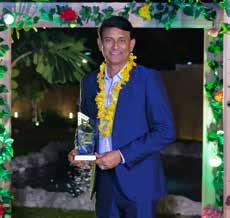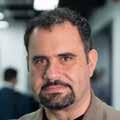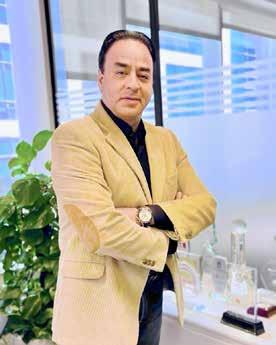CHANNEL INDUSTRY TRENDS AND PREDICTIONS FOR 2025
ELEVATING CHANNEL PARTNERSHIPS
WINNERS REVEALED CHAMPIONS OF THE CHANNEL AWARDS 2024

CHANNEL INDUSTRY TRENDS AND PREDICTIONS FOR 2025
ELEVATING CHANNEL PARTNERSHIPS
WINNERS REVEALED CHAMPIONS OF THE CHANNEL AWARDS 2024
An exclusive deep dive into ITQAN Al Khaleej’s Feras Al Jabi’s vision for driving digital transformation and success



















FORTINET EXPANDS PARTNERSHIP WITH E& UAE



EXABEAM AND WIZ PARTNER TO STRENGTHEN CLOUD SECURITY THREAT DETECTION
GCORE AND EZDITEK LAUNCH JOINT VENTURE TO ACCELERATE AI GROWTH IN KSA

TRANSFORMING CHALLENGES TO OPPORTUNITIES












As we close out another remarkable year in the channel ecosystem, it’s time to reflect on the trends that are reshaping our industry and ask ourselves a daring question: Are we ready to embrace radical change? The relentless pace of advancements in AI, cloud computing, and the growing imperatives for sustainability and security have not only transformed technology but also challenged our ways of thinking.
Getting radical means reimagining how we engage with partners, customers, and opportunities ahead. It’s about fostering deeper collaborations that transcend transactional relationships, pushing boundaries with bold strategies, and driving holistic growth that balances profitability with purpose. Sustainability, personalisation, and trust aren’t just trending concepts; they are the pillars shaping the future of the channel.
This edition’s cover story takes a closer look at these transformative shifts, featuring an exclusive interview with Feras Al Jabi from ITQAN Al Khaleej Computers. He shares insights into ITQAN’s evolution, its role in driving digital transformation, and its strategic roadmap for the future.
We also celebrate the trailblazers of the industry with the Champions of the Channel Awards 2024, honouring individuals and organisations whose vision and innovation are driving the channel forward. This vibrant event was a tribute to the passion, creativity, and resilience of the ecosystem.
Additionally, we spotlight key predictions and expert advice from industry leaders to help you navigate the dynamic landscape of 2025. From cuttingedge cybersecurity frameworks to eco-friendly product innovations, this issue explores the strategies that are reshaping the channel and beyond.
As we gear up for 2025, let’s pledge to be the catalysts of meaningful change. The future isn’t just about keeping pace—it’s about leading with courage, vision, and a touch of radical thinking.
Let’s make it happen - happy reading!
Published by
Publication licensed by Sharjah Media City
@Copyright 2024 Insight Media and Publishing
Managing Editor
Adelle Geronimo
adelleg@insightmediame.com
+97156 - 4847568
Production Head
James Tharian
jamest@insightmediame.com
+97156 - 4945966
Sales Director
Merle Carrasco
merlec@insightmediame.com
+97155 - 1181730
Administration Manager Fahida Afaf Bangod
fahidaa@insightmediame.com
+97156 - 5741456
Operations Director
Rajeesh Nair
rajeeshm@insightmediame.com
+97155 - 9383094
Designer Anup Sathyan
While the publisher has made all efforts to ensure the accuracy of information in this magazine, they will not be held responsible for any errors

Fortinet has announced that e& UAE, telecom arm of e&, will launch a managed secure SD-WAN service powered by Fortinet. The expanded partnership highlights both companies’ commitment to delivering secure networking solutions that enable digital transformation.
e& UAE has been a partner with Fortinet since 2015, delivering toptier security solutions to the UAE market across diverse sectors such as Government, Healthcare, Education, and Oil and Gas. In 2023, e& UAE was named a Secure Connectivity Partner of the Year by Fortinet. With the expanded partnership, e& UAE will enhance its Managed Firewall service with the addition of Fortinet Secure SD-WAN, bringing a host of benefits to organisations of all sizes in key sectors across the region, including improved operational efficiencies, enhanced security measures, and a scalable network infrastructure.
SD-WAN allows organisations of all sizes to improve application and user experience while enabling the flexibility and cost benefits of a hybrid network. Fortinet’s recent recognition is a testament to the ability of Fortinet Secure SD-WAN to enable businesses to protect their investment and simplify operations
along their journey to a Zero Trust Architecture.
Alain Penel, Vice President, Middle East, Turkey & CIS at Fortinet said, “Fortinet Secure SD-WAN improves network performance, reliability and security, facilitating smoother communication and collaboration among businesses, government agencies, and individuals. By enabling businesses to operate more efficiently and access cloud-based services seamlessly, the partnership with e& UAE will not only contribute to increased productivity, innovation, and competitiveness at the organisational level, but also on a wider socio-economic level, helping to drive economic growth in the region. Furthermore, Fortinet Secure SD-WAN has set Etisalat up with a strong foundation to seamlessly move from Managed SD-WAN to SASE and SD-Branch in the future.”
Hamad Mohamed Almarzooqi, Senior Vice President, Sales and Business Operations, e& UAE also commented, “Our strategic alignment with Fortinet supports our goal of providing the UAE market with access to leading SD-WAN solutions. These joint efforts will elevate the networking capabilities available to our customers, and reinforce our commitment
to service and support excellence. Recognising the critical role of SD-WAN in enterprise advancement, our value propositions are carefully designed to meet the diverse needs of our customers. Our mission goes beyond the delivery of technology; we are committed to the effective deployment and management of SD-WAN infrastructure and we draw on the industry’s most advanced expertise to fulfil this ambition.”
Fortinet supports its MSSP partners Fortinet continues to drive market evolution with secure networking solutions that deliver security effectiveness, cost, and performance for use cases spanning enterprises onpremises, multi-cloud environments, branch, and remote deployments. MSSP partners can build new services on Fortinet products that offer the flexibility to accommodate different architectural requirements specific to MSSP environments including multitenancy, custom portals, comprehensive automation and orchestration support, centralised management and analytics, custom reporting, and bulk deployment capabilities. Please visit the Fortinet Managed Security Service Providers page for more information about this programme.

Exabeam announced its partnership with Wiz. This collaboration provides organisations with improved threat detection, investigation, and response (TDIR) capabilities, ensuring a more secure and resilient cloud environment. With its open architecture, the Exabeam NewScale Security Operations Platform supports a best-of-breed ecosystem that includes hundreds of product integrations to accelerate time-tovalue and strengthen on-premises and cloud security.
“As organisations embrace cloud environments, the surge in cyberattacks is unprecedented, and visibility alone is not enough. Exabeam and Wiz are coming together to deliver what has been a missing piece in enterprise security,” said Steve Wilson, Chief Product Officer at Exabeam. “By uniting cutting-edge cloud security intelligence from Wiz with AIpowered analytics from Exabeam, we are transforming how security teams defend against evolving threats. Together, we’re empowering enterprises with the unmatched ability to see and stop attacks before they escalate.”
As cloud adoption continues to increase, so do the opportunities
for new attack vectors. According to Gartner, by 2027, investigations involving cloud or third-party infrastructure will account for more than two-thirds of all reported incidents. This surge in cloudfocused threats makes it crucial for organisations to adopt more robust, integrated cloud security strategies that provide complete visibility and actionable intelligence across hybrid environments.
With the Wiz integration, customers will experience enhanced cloud security insights and streamlined onboarding to the Exabeam New-Scale Platform. The collaboration will integrate Wiz’s in-depth visibility into toxic combinations of risk with Exabeam AI-driven behavioral analytics to give teams the ability to see trends of attack paths and remediation over time.
“At Dataminr, we’re thrilled to see two of our key security partners join forces to elevate our platform’s protection. The integration of comprehensive cloud security insights with AI-driven behavioral analytics will not only strengthen our defences but also streamline our security processes, enhancing our ability to safeguard both our data and
customers.”- Ryan Mednick, Senior Director, Cybersecurity and Trust at Dataminr
Additional benefits from this collaboration include:
• Comprehensive threat detection for streamlined investigations: By connecting Wiz’s cloud insights with data from other security tools, the Exabeam New-Scale Platform offers a unified view for investigations. This integration allows security teams to identify and analyse patterns over time, track issue trends, and quickly prioritise critical threats across cloud and hybrid environments, strengthening their response capabilities.
• Rapid and guided cloud security intelligence: The pre-configured Wiz tile in the Exabeam New-Scale Platform simplifies onboarding, accelerating access to Wiz insights. With full API documentation support, organisations can quickly integrate the solution into their workflows, save steps, and reduce the time it takes to protect cloud assets.
“Our partnership with Exabeam aims to make cloud security more accessible and effective for our customers,” said Oron Noha, VP of Product Extensibility & Partnerships at Wiz. “By combining our capabilities with advanced threat detection tools from Exabeam, we’re giving security teams the ability to see potential risks more clearly and respond faster. This partnership ensures that organisations can better protect their cloud environments without adding complexity to their operations.”
Exabeam and Wiz are poised to support even more organisations looking to fortify their cloud security. Exabeam will remain a catalyst for Wiz’s growing integration capabilities, powering their continued advancements to ensure customers stay ahead of emerging threats.

Gcore and Ezditek have launched a joint venture focused on providing high-performance AI infrastructure in the KSA. The joint venture will develop an ‘AI factory’, which can be used for building, training, and deploying generative AI solutions locally and across the globe.
The joint venture brings together Gcore’s expertise in cloud-based AI infrastructure and Ezditek’s innovative approach to sustainable and AI-centric data centre design and build. The joint venture is the result of an agreement signed by Gcore and Ezditek in May 2024 and will support the KSA’s position as a leading global
AI hub. The incorporation process of the joint venture is currently underway and is subject to regulatory approvals, including from the General Authority for Competition in the KSA.
“We are excited to join forces with Ezditek in building this groundbreaking AI factory. By combining our cloud services and AI infrastructure capabilities with Ezditek’s expertise in data centre development, we are setting a new standard for AI infrastructure in the region,” said Andre Reitenbach, CEO at Gcore.
The AI factory will be deployed in an Ezditek data centre and be home
Dynatrace has become a member of the Microsoft Intelligent Security Association (MISA) to provide customers with enhanced cloud security solutions through continuous innovation and collaboration with Microsoft and other MISA members. MISA is an ecosystem of independent software vendors (ISVs) and managed security service providers (MSSPs) that have integrated their solutions with
Microsoft security technology to better defend mutual customers against cyber threats, which are rapidly increasing. According to recent Dynatrace research, nearly 72 per cent of CISOs have faced application security incidents in the past two years.
Dynatrace was nominated to MISA because of its powerful integration with Microsoft’s SIEM solution, Microsoft Sentinel. Dynatrace delivers
to tens of thousands of GPUs that will empower organisations to train and deploy sophisticated generative AI models. This will enable the rapid training and development of predictive analytics models, deep data analysis, and process optimisation, as well as a growing number of AI use cases.
“Over the last six months, we have worked in collaboration with Gcore to identify areas where we can deliver the most value for customers, and support the KSA’s vision for AI leadership. Together, we are developing an AI factory purpose-built for enabling and accelerating AI innovation and adoption,” said Ibrahim Almulhim, CEO at Ezditek. “We’re extremely proud to be working with a global leader in AI enablement and bringing a visionary approach to AI innovation to market in the KSA.”
“This partnership will accelerate the adoption of AI and cloud computing solutions, benefiting businesses and citizens alike,” said Eng. Bassam Al-Bassam, Deputy Minister of Telecommunications and Digital Infrastructure at MCIT. Al-Bassam also pointed out that this partnership will boost digital investment and national digital capacity in Saudi Arabia, underpinned by its digital capabilities and reliable infrastructure.
comprehensive observability and security, offering vital insights that simplify cloud complexity and empower organisations to proactively combat evolving cyber threats. By merging the insights from Dynatrace with Microsoft Sentinel, organisations gain a more holistic understanding of their security posture. As a result, SecOps teams can detect application attack attempts more effectively, streamline incident management, and proactively mitigate issues as part of their efforts to keep their cloud-native environments secure and their business operations resilient.
“As cyber threats become increasingly
sophisticated and frequent, it’s imperative for organisations to proactively defend their IT environments,” said Jay Snyder, SVP, Global Partner and Alliances at Dynatrace. “With Dynatrace, teams gain end-to-end observability and security across all workloads. They can automatically identify vulnerabilities, measure risks, and leverage advanced analytics and automation to mitigate issues. As a MISA member, we look forward to collaborating with Microsoft and other members to develop best practices, share insights, and drive innovation in cloud-native security. We are excited to deepen our relationship with Microsoft, reaffirming our commitment to helping organisations innovate securely.”

“The Microsoft Intelligent Security Association has grown into a vibrant ecosystem comprised of the most reliable and trusted security software
vendors across the globe,” said Maria Thomson, Director, Microsoft Intelligent Security Association. “Our members, like Dynatrace, share Microsoft’s commitment to collaboration within the cybersecurity community to improve our customers’ ability to predict, detect, and respond to security threats faster.”
Established in 2018 to bring together Microsoft leaders, ISVs, and MSSPs, MISA focuses on collaborating to combat security threats and create a safer environment for all. Its mission is to provide intelligent, industry-leading security solutions that work together to help protect organisations at the speed and scale of AI in an ever-increasing threat landscape.

Saudi Arabia’s Vision 2030, which emphasises the importance of cybersecurity to drive digital transformation and economic diversification, has pushed the growth of the Saudi cybersecurity market which is projected to grow at a compound annual growth rate (CAGR) of 12.5 per cent, reaching SAR 15 billion by 2025.
innovate and scale securely in support of Saudi Vision 2030.”
OPSWAT has formed a strategic partnership with Technology Control Company (TCC), a prominent Saudi firm specialising in security services, digital solutions, and big data.
Through this partnership, TCC will implement and market OPSWAT’s unified MetaDefender platform, addressing critical challenges in malware detection, secure access, and data sanitisation. Together, OPSWAT and TCC will provide scalable, comprehensive solutions to protect Saudi Arabia’s essential IT and OT environments, addressing the growing demand for secure digital infrastructure across energy, finance, and government sectors.
The industry still faces a significant shortage of cybersecurity professionals, with an estimated gap of 500,000 experts across the Middle East. OPSWAT’s solutions, combined with its educational initiatives through OPSWAT Academy, aim to address this skills gap by upskilling local professionals and reducing dependency on highly specialised inhouse expertise through the solutions provided in collaboration with TCC.
“The demand for advanced cybersecurity solutions in Saudi Arabia has surged throughout 2023 and 2024, driven by the Kingdom’s ambitious digital transformation initiatives,” said Amjad Quteifan, Regional Sales Director at OPSWAT. “Through our partnership with TCC, we are uniquely positioned to deliver comprehensive security solutions that protect the critical infrastructure, empowering Saudi organisations to
TCC has been a trusted provider of cutting-edge security solutions across Saudi Arabia since 2008. Commenting on the partnership, Mohammed AlMarri, TCC’s General Manager of Cybersecurity Services, stated: “With the growing convergence of IT and OT environments, the demand for advanced cybersecurity solutions is at an all-time high. At TCC, we leverage decades of expertise to deliver tailored cybersecurity services that protect critical infrastructure and sensitive data. Through our partnership with OPSWAT, we enhance our ability to provide comprehensive, scalable solutions that empower organisations to navigate the evolving threat landscape and safeguard their most valuable assets with confidence.”
OPSWAT reinforced its commitment to supporting the Kingdom’s Vision 2030 objectives and the overall development of the cybersecurity industry by empowering Saudi businesses to overcome cybersecurity challenges and fortify critical infrastructure. Together, OPSWAT and TCC aim to further Saudi Arabia’s robust digital backbone, ensuring a secure and digitally scalable future.
Omnix International has announced a strategic partnership with Matterport. This new collaboration aims to accelerate the adoption of digital twins, creating immersive, high-quality virtual experiences of physical spaces across various sectors, including real estate, construction, hospitality, and insurance, allowing for virtual exploration and remote collaboration.
By combining Matterport’s cutting-edge 3D technology with Omnix International’s expertise in technology integration, customers are now empowered to make real spaces accessible from anywhere, which can drive sales, enhance customer satisfaction, and streamline operations.

Syscom and Zycoo have announced the signing of a strategic distribution agreement. Through this agreement, Syscom will distribute Zycoo’s innovative solutions to its extensive network of resellers and partners across the UAE, Oman, Qatar, KSA and Pakistan. This partnership will enable Syscom to offer its customers a wider range of best-in-class IT solutions and services, while Zycoo gains access to Syscom’s established distribution network and market expertise.
“We are excited to partner with Zycoo to bring their cutting-edge solutions to our
Walid Gomaa, CEO of Omnix International, stated, “Our commitment to leading the way in digital transformation is further solidified with our partnership with Matterport. We are excited to offer our customers innovative spatial data solutions that improve accessibility, documentation, and decision-making, while also reducing costs.”
“This partnership will combine Matterport’s cutting-edge spatial data technology with Omnix’s deep industry insights, delivering enhanced solutions for customers focused on Industry 4.0, environmental sustainability, and cross-functional collaboration. As a trusted value-added reseller in the
region, Omnix will enable us to make digital transformation more accessible, impactful, and user-friendly,” said Nick Halls Senior Director for Channel Sales EMEA at Matterport. “Together, Matterport and Omnix are excited to bring powerful, integrated solutions to drive efficiency, improve outcomes, and support a sustainable future for businesses across the GCC.”
The Middle East is experiencing a growing demand for digital solutions across various industries. Different sectors are set to benefit from Matterport’s technology, with digital replicas for physical spaces aiding in precise visualisation and efficient management, which is invaluable for project planning and management.
This partnership aims to target largescale projects in areas such as real estate development, infrastructure, and smart cities, showcasing the combined strengths of Omnix International and Matterport in delivering high-value digital solutions.
customers across the region,” said Hamid Ansari, Managing Director, Syscom. “Zycoo’s innovative audio technology solutions are a perfect complement to our existing portfolio, and we are confident that this partnership will be mutually beneficial.”
Oneil Pinto, Vice President, Zycoo, stated that ‘’Syscom’s extensive expertise in delivering value-added services, supported by a large pool of technical resources and a broad distribution network across the Middle East & Africa (MEA) region, will significantly enhance the effectiveness of our solution, providing greater value and a wider reach for our clients.’’
Syscom offers a comprehensive portfolio of IT solutions from the world’s leading vendors and is dedicated to helping its customers achieve their business goals. Syscom has a proven track record of success and is known for its expertise, commitment to customer satisfaction, and strong relationships with its partners.
Zycoo is a prominent global developer and manufacturer, specialising in advanced IP Telephony, IP Intercom, and IP Public Address Systems. The company has carved a niche in the field of Unified IP Communication solutions, with a strong emphasis on cutting-edge technologies such as SIP (Session Initiation Protocol), Streaming Media, and MQTT IoT (Internet of Things). These technologies enable Zycoo to offer integrated, all-in-one communication systems that enhance audio communication across various business environments. Zycoo’s solutions are renowned for their reliability and ability to streamline communications, making them a trusted partner for businesses worldwide seeking to enhance their communication infrastructure. This strategic alliance between Syscom and Zycoo marks a significant step forward in delivering advanced IT solutions to businesses across the regions of UAE, Oman, Qatar, KSA and Pakistan. By combining their strengths and expertise, the two companies are poised to drive innovation and empower organisations to achieve their goals.







































Key moments contributing to success
Shaista Ahmed attributes her success and growth in the channel industry to a blend of hard work, strategic thinking, relationship-building, and adaptability. She highlights the importance of cultivating trust and collaboration while building longterm relationships with culturally diverse partners across the region—a cornerstone of her achievements in channel sales. She acknowledges that the fast-paced nature of the industry often brings setbacks, but views these as opportunities for growth. Overcoming challenges has taught her resilience, adaptability, and problem-solving under pressure, enhancing her leadership skills. For her, the journey—embracing new technologies, securing significant deals, leading teams, and learning from failures—is what shapes a fulfilling and impactful career.
Overcoming obstacles
Shaista reflects on the challenges of operating in the Middle East’s diverse channel sector, where cultural, linguistic, and business practices vary significantly across countries. She acknowledges key obstacles such as intense competition, financial stability issues, rapid technological changes, market fragmentation, and concerns over customer loyalty and cybersecurity. Despite these complexities, Shaista and her team have successfully provided a safety net for their partners. They achieved this by grounding partnerships in four essential pillars: trust, profitability, great products, and longterm recurring revenue streams. These principles have been instrumental in positioning their partners for sustained success in a challenging landscape.
Emphasising the importance of a dynamic and adaptable leadership approach in the ever-evolving tech industry, she highlights strategies such as fostering a culture of continuous learning, prioritising team development, and maintaining agility in response to market shifts. Shaista also underscores the critical role of innovation and strong partner relationships in driving organisational success. By keeping customer-centricity at the forefront and promoting cross-functional collaboration, she ensures her team remains resilient and forwardthinking. These elements collectively enable her team to effectively navigate challenges and seize opportunities, securing long-term growth and success in a rapidly changing business environment.
Identifying the dynamic trends and challenges shaping the future of the channel industry, particularly in technology distribution and partnerships, Shaista emphasises the importance of anticipating shifts like digital transformation, cloud migration, AI and automation integration, and increasing cybersecurity demands. Navigating global market instability and geopolitical risks also play a significant role in staying competitive.
Shaista believes the key to success lies in adapting quickly to these trends, investing in innovation, and building resilience against challenges such as talent shortages and evolving customer expectations. By fostering
continuous learning, leveraging data-driven decisions, and embracing collaboration, she ensures her team thrives in an increasingly complex and competitive landscape.
She exemplifies the dual qualities of strategic vision and hands-on leadership to drive innovation, collaboration, and influence within the channel ecosystem. Recognising the diverse roles of vendors, distributors, resellers, and end customers, she prioritises trust, value creation, and long-term relationships. To sustain her positive impact, Shaista focuses on technological innovation, fostering collaboration across industries, and advocating for education and skill development. Her approach is centred on building a customer-centric, sustainable business environment. By adopting a holistic, forward-thinking strategy, she aims to elevate the channel community, positioning it as a pivotal driver of digital transformation and enduring business success.
Drawing from over 20 years of experience, her advice for emerging leaders in the channel sector is to blend vision with action, empathy with strategy, and resilience with adaptability. A successful leader must focus not only on driving sales but also on creating an environment where innovation, collaboration, and customer success are paramount. Building strong relationships, embracing technology, fostering talent, and maintaining a long-term, customer-centric vision are essential to growing as a leader and making a lasting impact on the channel industry.

Sakkeer Hussain, Director of Sales & Marketing, D-Link Middle East and Africa, discusses how the company’s PoE solutions drive efficiency and scalability for businesses of all sizes
What makes the Unmanaged PoE switches userfriendly for nontechnical users?
D-Link offers a wide range of unmanaged PoE switches, which are user-friendly due to their plug-and-play setup, simplifying installation without configuration requirements. The PoE switches enable seamless integration of PoE devices like IP cameras, IP phones, and Wireless Access Points and are ideal for quick, efficient deployments. Additionally, D-Link’s energyefficient designs reduce costs and improve reliability, making these switches cost-effective for various applications. D-Link under their portfolio carries a wide range of unmanaged PoE switches supporting network requirements to support long-range connectivity up to 250 meters.
How do the edge PoE switches enhance network management?
D-Link offers POE switches in the managed and unmanaged categories. With its wide range of Product portfolio, it gives solutions to project requirements with today’s IT Infrastructure requirements. The PoE switches we carry under our portfolio are industry standard with supporting MultiG Fiber uplink ports, 803.1bt, long-range connectivity up to 300 meters. With the managed product portfolio on D-Link PoE switches, the products offered intuitive UI for end users to tune the configuration parameters easily.
How does D-Link cater to both small businesses and large enterprises with this PoE lineup?
D-Link’s PoE lineup caters to both small businesses and large enterprises with a wide variety of product series options covering Long range, websmart, layer2 stackable, layer3 stackable series with 1G and 10G SFP uplinks on them. The products offer scalable solutions from the edge to the core, combining high performance, energy efficiency, and reliable support services.
What impact does the smart software have on network stability?
D-Link with its centralised management solution with multisite flexibility on its platform D-View 8 helps administrators to easily manage enterprise networks. The management software simples the troubleshooting to zero down the areas which need attention.
What unique advantages does the PoE Power Rangers lineup offer in today’s market?
D-Link’s PoE lineup delivers top-tier performance with over 45 PoE-enabled switches offering up to 740 Watts per switch, ideal for supporting high-demand infrastructures like IP cameras, telephony, and access points. With extensive 10 Gigabit connectivity options in both Fiber and Copper, the lineup ensures unmatched speed, reliability, and flexibility. D-Link’s eco-friendly designs and

D-Link’s PoE lineup caters to both small businesses and large enterprises with a wide variety of product series options covering Long range, websmart, layer2 stackable, layer3 stackable series with 1G and 10G SFP uplinks on them”
robust support packages further reduce costs, making it a marketleading solution.




As ITQAN Al Khaleej Computers celebrates its 40th anniversary, the company reflects on its remarkable journey in shaping the UAE’s digital landscape. In an engaging conversation, Feras Al Jabi, General Manager of ITQAN, shares insights into the organisation’s evolution, its pivotal role in driving digital transformation, and it’s strategic roadmap for the future
Could you share some highlights of the company’s journey so far?
This year, we are proudly celebrating 40 years of excellence, marking a legacy of impactful contributions to the UAE’s digital transformation journey since its establishment in 1984. As a leading systems integrator, we have consistently been at the forefront of introducing and implementing innovative technologies, collaborating with global providers to deliver engineered and re-engineered solutions customised to the needs of our clients. Our partnerships with global technology providers have allowed us to bring cutting-edge solutions to our clients in industries like defence, healthcare, education, oil and gas, and government services. These contributions have earned recognition and trust from enterprises and government organisations alike, cementing our position as a leader in the ICT sector.
As a team of highly skilled professionals, we have successfully delivered complex projects, combining cutting-edge software and hardware solutions. As a result, we are recognised as one of the top five systems integrators and solutions providers not only in the UAE but also across the GCC and Middle East region.
You’ve been with ITQAN since 1998. How has the systems integration industry evolved over the years?
The ICT industry has always been highly dynamic, evolving in response to global trends and technological shifts. Since the 1990s, when organisations prioritised PCs and local networks, ITQAN has been instrumental in driving transformation initiatives. Starting with office operations and extending into areas like document management systems, healthcare information systems, e-commerce, and e-government, ITQAN has consistently adapted to the changing landscape.
Over the past 25 years, we have played a key role in significant transformations, such as the shift from web-based government services to mobile platforms and, more recently, to data analytics and AI-driven solutions. The UAE market’s quick adoption of these global trends has allowed us to stay at the forefront of innovation, particularly in cybersecurity, a core focus area for the company.
In addition, our leadership in AI initiatives is exemplified by its subsidiary, Digital Okta, launched in 2016. This cloud-first company has leveraged Microsoft Azure and other cloud platforms to drive AI-powered solutions. These initiatives include deploying cloud-based AI for enhanced organisational operations, data fabric




solutions, and tools like co-pilot systems to optimise back-office and user-facing functionalities. By capitalising on AI and cloud computing, we continue to deliver transformative solutions, empowering clients to harness technology for operational efficiency and strategic growth.
What do you think are the key challenges in the journey of digital transformation?
Digital transformation presents unique challenges, particularly in aligning business goals with technological initiatives. We believe that transformation must be business-driven and supported by IT. Organisations need to first define their competitive goals and then leverage technology to achieve them. This perspective has shifted the role of IT leaders, positioning CIOs as strategic partners on par with CFOs and COOs. The emergence of roles like Chief AI Officers, especially in Dubai’s government, reflects this evolution.
However, resistance to change remains a significant challenge. Digital transformation necessitates buy-in from all stakeholders, as projects that lack alignment between technology and its users often fail. Technology should be seen as an enabler, not a mandate, ensuring that transformation efforts are goaloriented and impactful.
Successful transformations highlight the power of welldefined goals and technological enablement. Companies like Uber, which revolutionised transportation, and food delivery platforms that expanded restaurant capacities, exemplify this principle. These successes stem from leveraging cloud computing, AI, data analytics, and mobile technology to address specific business challenges. Similarly, industries such as sports, agriculture, healthcare, banking, and defence have harnessed realtime data and analytics to drive innovation and efficiency. For
Our partnerships with global technology providers have allowed us to bring cuttingedge solutions to our clients in industries like defence, healthcare, education, oil and gas, and government services”
instance, in Formula 1, real-time data from car sensors enhances driver performance during races. Ultimately, transformation is about aligning vision, technology, and strategy to drive measurable business outcomes.
How does ITQAN stay ahead of the curve in such a competitive landscape?
At ITQAN, we pride ourselves on offering a comprehensive portfolio of cybersecurity services, spanning advisory, deployment, implementation, training, and postdeployment support. Our approach emphasises understanding the client’s specific threats and business needs, rather than relying solely on offthe-shelf technologies. We focus on creating a harmonious integration of various technologies to deliver the most effective solutions. This differentiates us from others in the market, as we are not simply product sellers but partners in cybersecurity transformation.
What are your thoughts on the future of AI and other emerging technologies?
AI continues to grow and evolve, with advancements over the past year including conversational AI like ChatGPT, CoPilot, Google Bard, and many others. These tools have permeated various industries and use cases, driving significant

transformations. More recently, generative AI has emerged, representing the next evolution of artificial intelligence. The future of AI will likely involve further innovations, adapting to new demands and applications while staying true to its core purpose: enabling intelligent automation and decision-making.
However, AI’s efficiency relies heavily on proper data. Without well-structured, managed, and accessible data, AI cannot deliver meaningful benefits. Data readiness, including strong data science foundations, remains a critical first step in any AI initiative, ensuring that the technology can function effectively and deliver tangible results.

Quantum computing is increasingly seen as a complementary force to AI, especially as traditional hardware struggles to meet the computational demands of AI and high-performance computing. Last year, we became the first company in the UAE to move toward quantum computing by partnering with Equa, a U.S.based company offering quantum devices capable of operating at room temperature. Quantum computing holds immense potential for accelerating AI advancements, given its ability to process complex algorithms and vast amounts of data more efficiently than current technologies. Recognising its transformative potential, we began preparing for this shift in 2023.
ITQAN is celebrating 40 years of excellence. What’s next for the company?
The upcoming chapter for ITQAN will emphasize advancements in robotics, artificial intelligence, and data analytics. Our objective is to revolutionize industries by integrating cutting-edge technologies with innovative solutions. Strategic global partnerships will remain integral to this endeavour.
We take pride in our strong association with the UAE, which leads the region in digital transformation. While global expansion is a consideration, our primary focus is on being an essential component of the UAE’s digital landscape.
Any final messages for your customers and the market?
ITQAN’s 40-year journey would not have been possible without the trust of our customers, the dedication of our employees, and the support of our partners. We are committed to building on this legacy by continuing to deliver innovative solutions and exceptional service.
We believe the UAE offers unparalleled growth opportunities, and we are excited to contribute to its digital transformation journey for years to come. Thank you for trusting us to be your partner in this evolving landscape.

Cybersecurity decision-makers are struggling with elevating the business value and business alignment of their role and Ranjith Kaippada, Managing Director, Cloud Box Technologies describes a framework that can help reach these objectives
Large-scale adoption of digital and business transformation by global and regional enterprises and the associated cybersecurity vulnerabilities has driven the realisation of the importance of keeping cybersecurity at the same levels as other strategic priorities of the enterprise.
According to IDC, security is now a board-level conversation and cyber risk has been elevated and is now recognised as a business risk. According to Gartner, the importance of information security is rising rapidly as senior executives become aware that poor security can cause irreparable damage to the business. Gartner forecasts that by 2026, 70 per cent of boards will include one member with cybersecurity experience.
However, this rapid onslaught of digital transformation with migration to the cloud and adoption of digital platforms, followed by the more recent drive to embed Generative AI into business processes is not making things easier for cybersecurity administrators and decision-makers.
The continued heightened threat environment, cloud migration and talent crunch are pushing security to the top of the priorities list and pressing cybersecurity administrators and decision-makers to increase their organisation’s security spending. As organisations continue to move to the cloud, Gartner analysts expect an increase in cloud security solutions, and the market share of cloud-native solutions will grow.
In reality, the emergence of Generative AI and other AI technologies is contributing to increased budgets for security offerings in 2024. Generative AI is driving an increase in cybersecurity spending to secure an organisation’s development and use of Generative AI applications, as well as to use Generative AI assistants to support security administrators in efficiency.
The adoption of AI and Generative AI continues to drive an increase in investments in security software like application security, data security and privacy, and infrastructure protection. Generative AI will trigger a spike in the cybersecurity resources required to secure it, leading to an expected 15 per cent increase in security software spending, forecasts Gartner.
Furthermore, organisations are currently assessing their endpoint protection platform and endpoint detection and response needs and adjusting to boost operational resilience and incident response following the CrowdStrike outage.
Since the release of Generative AI, attackers are increasingly employing tools along with large language models to carry out large-scale social engineering attacks. Gartner predicts that by 2027, 17 per cent of total cyberattacks and data leaks will involve Generative AI.
Security spending will continue to remain strong and isolated from the recessive effects of a challenging macro-economic global environment and economic uncertainty.

implementations. This may have little relevance to the business of the enterprise, its position in global and regional markets, and its changing business value in the competitive marketplace.
A well-thought and plannedout cybersecurity framework has multiple components. These can be listed as:
• Overall strategy
• Collection of operational processes
• Accountability and governance
• Correlation to the rest of the enterprise
• Mandate for operational execution
The way forward for cybersecurity administrators and decision makers is to build a forward looking cybersecurity framework that manages continuous digital and business transformation, helps to create new business value in the face of these changes, takes into consideration internal and external factors, and plans for growing risks and threats.
In the absence of such a forwardlooking cybersecurity framework, the role of cybersecurity administrators and cybersecurity decision-makers may be relegated to merely managing technology solutions and technology
A fully functional enterprise cybersecurity framework consists of security policies, security processes and security architectures. It defines users, systems and configurations. It provides guidance for future design, implementations and successful operations.
Amongst the forward-looking steps is to build competency in reverse engineering of threats, determination of threat origins, monitoring of advanced threats, enterprise-wide incident response capabilities, and action plans for employees in the face of threat actor intrusions.
A well-developed enterprise cybersecurity framework allows for future evolution and is adaptive to changes in the threat landscape. This exercise cannot be completed in a hurry and must be well-mapped to the business organisation of the enterprise.
Gartner predicts that by 2027, 17 per cent of total cyberattacks and data leaks will involve Generative AI
Developing this framework is a team effort from across the enterprise and involves business decision-makers whose presence helps to collectively shoulder the risk and governance across the enterprise.
By following the above steps, cybersecurity decision-makers can help the security function align with business and also showcase the importance of its role and the value it can offer today and in the future as well.
Champions of the Channel Awards 2024 shines the spotlight on the best in the channel

On 10th December we proudly hosted the third edition of the Champions of the Channel Awards, celebrating the vital contributions of the channel community. This incredible event brought together the individuals and organisations who play a pivotal role in driving technological innovation and helping businesses achieve their goals.


The evening embraced a vibrant Hawaiian theme, complete with music, dance, and an infectious spirit of celebration. The atmosphere was electric, with attendees enjoying the perfect blend of camaraderie and fun.
At its core, the event was a tribute to hard work, vision, and innovation. It recognised the game-changers and trailblazers whose ideas are shaping the future of the channel industry. From thought leaders to creative strategists, the Champions of the Channel Awards honoured the brilliance and passion driving this dynamic ecosystem.
Congratulations to the winners who earned well-deserved recognition for their exceptional contributions. Browse through the pages to witness their achievements and moments of celebration.

Spire Solutions
Cybersecurity Innovator of the Year

Teksalah
IT Security Services Provider of the Year

Visiontech Systems International
Excellence in Cloud Managed Services

Syscom Distribution
Networking Distributor of the Year

Cloud Box Technologies
AI System Integrator of the Year

D-Link Middle East
Network Solutions Provider of the Year

Elitser Technologies
Managed Services Innovator of the Year

Finesse Excellence in Digital Transformation

Lenovo Infrastructure Solutions Provider of the Year

emt Distribution
Cybersecurity Distributor of the Year

Trigon
ICT Distributor of the Year

ITQAN Al Khaleej Computers
System Integration Specialist of the Year















Fissal Oubida Lexar

Shahnawaz Siddiqui Allied Telesis

Aliasgar Dohadwala Visiontech Systems International

Kamran Khayal Trigon

Hamid Ansari Syscom International

K.S. Parag FVC





Alaa Salameh Recorded Future



Amrita Nag
Omnix International

Goher Ali Rizvi ITQAN Al Khaleej Computers

Mohammed Iqbal Logitech

Kamlesh Lal Dell Technologies

Fadi Sarhan Fortinet

Shaed Khader Logicom Distribution UAE & Gulf

Vasu Sharma FVC






From secure connectivity to seamless performance, our switches and networking solutions are built to keep you ahead in an ever-evolving digital landscape. Trusted by clients and partners worldwide, we deliver the value and reliability you need.
The x240 Series allow you to build a high-performing network access solution with multi-gigabit speeds of 10M/100M/1/2.5/5G on all edge ports to connect any device, old or new.
Power high-end devices with up to 90W power delivery
Enjoy high-speed Wi-Fi through existing cabling
Leading the way in network solutions since 1987
For more information, please contact one of our

As the channel industry gears up for 2025, leaders are reflecting on the lessons learned in 2024 and the evolving trends that will shape the coming year. To gain a clearer understanding of what new year holds, we spoke with industry leaders to gather their insights. Read on to discover their valuable predictions and expert advice for navigating the dynamic landscape of the channel industry

Narayanan Venkataraman, Head of Omni Channel of MEA, HP
Emerging technologies, particularly AI, are poised to reshape channel partnerships in 2025, opening doors for innovative value creation. A prime example is the HP Workforce Experience Platform, an AI-enabled digital experience tool that redefines the traditional PC refresh cycle. By analysing employee usage patterns, it provides personalised technology recommendations, boosts productivity, and automates support requests, reducing IT costs. Moreover, the platform integrates HP Wolf Security to mitigate security risks effectively.
Edge computing and IoT are also driving significant transformations. These technologies address the increasing demand for localised, real-time data processing, enabling channel partners to deliver agile solutions that enhance operational efficiency. This fosters stronger collaboration between partners and technology providers, paving the way for co-developing solutions tailored to the rapidly evolving digital landscape.
However, the shift to AI-driven solutions presents challenges, including the need for specialised expertise in data science and machine learning. Many partners face a knowledge gap in delivering customised AI solutions that align with business objectives. To address these challenges, the HP Amplify AI programme, introduced at HP Imagine, equips partners with AI solutions, training, and collaborative tools, enabling them to adopt AI with confidence. This approach ensures industry-specific solutions while maintaining a strong focus on data security and compliance. Customer demand in 2025 will prioritise sustainability, advanced analytics, and seamless partner ecosystems. Subscription-based and as-a-service models will gain momentum, complemented by eco-friendly technologies such as energy-efficient devices and e-waste solutions. Additionally, cybersecurity, compliance, and collaborative selling will drive channel strategies, requiring vendors and partners to adapt to regional and global demands for enhanced customer experiences.

Emerging technologies are set to redefine channel partnerships in 2025, with cybersecurity taking centre stage. Channel partners are constantly seeking ways to elevate their clients’ offerings by addressing evolving IT and cybersecurity challenges. With the alarming rise of ransomware attacks and extortion campaigns, the implications are devastating—ranging from reputational damage and data leaks to severe financial losses. Solutions like Halcyon Technologies’ Ransomware Prevention, Protection, and Real-Time Data Recovery Platform provide partners with the opportunity to stand out by delivering enhanced cybersecurity resilience to their clients.
The adoption of AI-driven solutions presents unique challenges for partners. One major hurdle is acquiring comprehensive knowledge of these solutions and their diverse applications. AI implementations vary significantly across organisations, making it vital for partners to discern genuine capabilities from market hype. Halcyon Technologies exemplifies this by leveraging AI models tailored to combat ransomware groups and Ransomwareas-a-Service (RaaS) providers. This targeted approach enhances the platform’s prevention capabilities and fortifies cybersecurity defences.
As customer demands evolve, channel partners must align their strategies to address key trends in 2025. Priorities include driving secure business digital transformation powered by AI, enabling seamless cloud integration, and fortifying cybersecurity frameworks. Emphasising Zero Trust architectures, ransomware prevention, and real-time recovery solutions is critical. Moreover, the convergence of IT and OT systems presents opportunities to optimise operations and strengthen security in interconnected environments. Partners who adapt to these trends will not only meet market demands but also build stronger, futureready relationships with their clients.

AI, 5G, and platform integration are emerging technologies that are fundamentally transforming channel partnerships. The shift is towards creating ecosystem-based solutions where tools from various vendors work together seamlessly, allowing partners to provide end-to-end services. This approach is less about isolated technology offerings and more about building cohesive solutions that meet clients’ needs for integrated workflows and adaptable security. As this ecosystem trend gains traction, channel partnerships will need to evolve, becoming more collaborative and focusing on seamless interconnectivity across platforms.
AI brings both exciting opportunities and some complex operational demands. A primary challenge is that AIdriven solutions require significant resources, particularly when managing sophisticated, adaptive threats that can be persistent. Partners will need to build operational resilience to keep up with these evolving demands, as attacks may continue over days and target multiple vulnerabilities. Additionally, clients are increasingly looking for AI solutions that fully integrate within their platforms, pushing partners to go beyond standalone features. The focus will be on ensuring that AI tools deliver accurate and actionable insights, balancing innovation with practical implementation requirements.
In 2025, customers are expected to seek comprehensive, integrated solutions rather than standalone services. There is growing interest in ecosystem platforms where security and analytics tools work together to provide unified insights. Additionally, clients are experimenting with natural language querying within AI models, indicating a demand for
tools that make data insights more accessible and actionable. As security concerns heighten, supply chain protection and multi-cloud resilience will also be critical areas where channel partners can support clients, helping them manage risks in interconnected digital environments.

Emerging technologies like IoT and OT security management will significantly reshape channel partnerships in 2025 by emphasising the need for deep specialisation. As enterprises adopt IoT and OT devices at scale, the demand for tailored security solutions will grow. Channel partners must focus on becoming trusted advisors, offering solutions that integrate visibility, risk management, and remediation into complex IT/OT infrastructures. IoT and OT are increasingly fitting into broader security strategies. Channel partners can gain traction by presenting well-rounded solutions that fit IoT and OT into the larger picture, ensuring that IoT and OT environments remain secure amid rapid technological advances.
With 65 billion IoT/OT devices in the world and growing, (10x more than traditional endpoints), organisations aren’t going to be able to rely solely on people to manage their devices. Partners will need to understand how AI-driven solutions and autonomous operations can help play a role in strengthening IoT and OT security management. Partners must be able to advise how AI models can enhance vulnerability identification and management while avoiding pitfalls of AI.
As organisations continue to understand the security risks associated with IoT and OT devices, they’ll start to shift from solutions that offer only visibility to solutions that offer complete security management including risk assessment, and real-time remediation. As more enterprises embrace the business benefits of IoT and OT devices, the need for proactive, scalable security frameworks that cover all cyberphysical systems will grow. Channel partners should also anticipate heightened demand for edge security solutions that secure data closer to where it’s generated. Regulatory compliance will drive demand for solutions that not only protect devices but also ensure adherence to industry standards. Lastly, as attacks on critical infrastructure increase, customers will seek zero-trust architectures and AI-powered tools to mitigate risks effectively across their entire ecosystem.

Ilya Leonov, Regional Director MENA, Positive Technologies
Emerging technologies are driving the evolution of channel partnerships toward managed services, with MSSPs (Managed Security Service Providers) playing a pivotal role. As businesses demand always-on support, robust cybersecurity, and proactive threat management,
MSSPs will become key partners, leveraging AI and automation to deliver scalable, predictive services. The shift toward subscription-based models will also push partners to offer comprehensive, end-to-end solutions, focusing on operational excellence and measurable outcomes. This trend emphasises the need for specialisation and ongoing innovation in managed services to meet dynamic customer demands effectively.
AI-driven solutions will require partners to overcome skill gaps, data integration complexities, and ethical considerations. Training and reskilling teams to handle AI models and analytics will be critical, as will the ability to align AI capabilities with customer-specific use cases. Managing concerns around data privacy and compliance in a rapidly evolving regulatory landscape will also pose challenges. Moreover, partners must differentiate themselves in a crowded market by demonstrating clear ROI and fostering trust in AI adoption.
In 2025, OT (Operational Technology) security will be in demand, driven by the urgent need to protect critical infrastructure and industrial systems. With the rise of interconnected environments across industries such as energy, manufacturing, and transportation, the risk of cyber threats targeting OT systems has escalated significantly. Channel partners should focus on delivering tailored OT security offerings, including managed services, to meet the growing demand for robust protection in this high-stakes domain.

We’re already seeing AI and machine learning technologies opening up huge opportunities for channel partners to deliver high-margin, differentiated solutions that customers are actively seeking. As vendors like us invest heavily in innovating around AI capabilities for data infrastructure, channel partners who can quickly build out specialised expertise and services around our offerings will stand out—and earn a premium in the process. This shift will also drive more collaborative ecosystems where partners are more than resellers; they’re co-creators, adding value to the end solution. The result? Stronger partnerships, new revenue models, and recurring revenue streams that increase customer retention and profitability.
AI is a fast-evolving field, and there are a few challenges to watch out for. First, the talent gap: partners who invest early in AI and data science training for their teams will be positioned to deliver these in-demand services at a premium. Second, integrating AI into existing customer environments can be complex. So, Partners who have the right AI-ready tech stack and services to assist customers with the AI build, operate and transition journey are crucial to avoid project delays and cost overruns. Additionally, as regulations increase, partners need to navigate these and the growing concerns around data privacy—both of which are becoming non-negotiables for many global customers and can make or break deals. Staying agile and informed on these issues will be key to capturing value while staying compliant.
We’re expecting to see several trends materialise that will directly impact the bottom line. AI-powered insights and automation will be at the top of customers’ wish lists, so partners offering solutions that improve operational efficiency or enable faster decision-making will be in high demand. We also see data security and compliance continuing to rise as top priorities; partners who can offer secure, compliant solutions will command a higher margin in industries like finance, life sciences, and healthcare. Scalability is another key—customers want solutions that grow with their business without the need for constant overhauls, creating recurring revenue opportunities. And finally, sustainability has become an essential part of the buying process in some markets, especially with larger enterprises. Doing more with less has always been an ask, but now with a focus on more sustainable or eco-friendly solutions, it could also become a competitive advantage in closing high-value enterprise deals.

Geoff Greenlaw, Vice President, EMEA & LATAM Channel Sales, Pure Storage
In 2025 businesses need to be efficient with their technology purchasing decisions, this means adopting technology to solve a holistic business outcome. This could be business continuity, cybersecurity, sustainability, or a number of other goals. Conversely, businesses will avoid individual products and solutions to solve isolated problems and pain points, as this leads to technology sprawl, a lack of interoperability, wasted resources as well as skills and knowledge silos across the business.
The partners who will succeed in 2025 are those who can bring a complete solution to a customer to solve for a business outcome. This might mean bringing together technologies from multiple vendors, therefore the importance of working with alliances and partnerships cannot be overstated. Lastly, it will be critical for these partners to present a comprehensive and clear ROI for said business outcome.
Beyond the simple transition from Capex to Opex, we will see the increased adoption of real services. In the wake of ‘everything-as-a-service,’ organisations have discovered that there is a major difference between opex billing, and true, value-added service. Challenging economic conditions mean that budgets are tight, and waste is unacceptable. It’s great to have subscription billing, but if the service itself isn’t flexible, or supported with robust guarantees from the vendor, business outcomes will not be met, and precious time and resources will be wasted. Ultimately, customers are going to vote with their dollars if vendors continue to offer substandard ‘services’ which don’t put the customer’s needs front and centre, with meaningful SLAs, ensuring ROI for the customer.

Paul Flannery, VP channel sales - International, Epicor
AI will remain the influential technology paradigm through 2025. As it shapes the new era of Cognitive ERP platforms, it will further accelerate the move to the cloud, so
end customers can embrace cutting-edge advancements in the most rapid and streamlined manner. This will require partners to adopt a cloud-first mindset. Along with this, those that utilise AI’s unparalleled ability to draw actionable insight from volumes of data to develop expertise in analytics and business intelligence, will be able to create compelling value for their customers.
Leveraging AI for impactful use cases, such as business intelligence and analytics, will require partners to develop new skill sets. In particular, they will need to develop a deeper understanding of not just the technical elements of their customers’ operations, but also the business aspects. As AI empowers them to move up the value chain, they will need to be comfortable in moving seamlessly from engineering, production and operations into the Boardroom, where they’ll now have to engage with stakeholders such as CFOs and other C-suite executives.
To rapidly react to market dynamics, CEOs and decision makers need quick, convenient and comprehensive views of their business. Gone are the days when they could pour through multiple spreadsheets. Today, they need powerful dashboards that present an overview via a single pane of glass. While the demand for AI-enabled automation is a given, many are now exploring how their decision making can be aided by AI simulations of ‘what if’ scenarios.

Tertius Wolfaardt, Architecture & Engineering Manager, Axis Communication
By 2025, emerging technologies, particularly AI and edge computing, will redefine channel partnerships, enabling advanced, value-driven solutions. AI-powered video analytics will transform cameras into multifunctional IoT sensors, opening opportunities beyond traditional security applications. Edge technologies will enhance decentralised analytics, reducing latency and supporting scalable, cloud-native solutions with remote management.
Cybersecurity will remain critical, offering partners a chance to differentiate through robust solutions. Global ESG goals will further influence technology decisions, driving demand for sustainable practices and eco-friendly technologies. Managed services will gain traction as businesses seek external expertise to navigate complex IT environments, allowing them to focus on core operations. Cloud-first and hybrid solutions will also dominate, blending on-premises and cloud infrastructure for flexibility, scalability, and cost efficiency.
Key challenges include integrating AI with legacy systems, bridging skills gaps, and managing compliance with data privacy regulations like GDPR and CCPA. Secure handling of vast data volumes is crucial to avoid breaches and regulatory penalties. Businesses will also demand tailored AI solutions and enhanced employee training to remain competitive.
Sustainability will take centre stage, with energy-efficient data centres and renewable energy adoption reducing carbon footprints. Operational continuity will be prioritised through investments in robust backup systems, disaster recovery, and resilience strategies to minimise disruptions.
2025 will emphasise technological integration, sustainability, security, and continuous learning, equipping organisations to adapt and thrive in a fast-evolving digital landscape.

Prabhu Jayaram, Senior Channel Development Manager- META & CIS, OPSWAT
Emerging technologies that can be seen shaping the future of channel partnerships in the tech industry are the advancement in AI, digital transformation, and cloud technologies. AI enhances threat detection, vulnerability management, and response capabilities, enabling channel partners to offer advanced security solutions that proactively mitigate cyber threats. Automating repetitive tasks allows cybersecurity professionals to focus on strategic activities. The adoption of digital transformation and cloud platforms also presents opportunities for channel partners to offer comprehensive security solutions tailored to businesses undergoing these changes. This includes securing cloud environments and ensuring compliance. Digital transformation reshapes vendor partner programmes, requiring alignment with modern technologies and cloud platforms. Channel partners can enhance their value proposition by integrating these trends into their offerings. As more businesses transition to cloud environments or adopt hybrid IT infrastructures, there will be increased demand for comprehensive cloud security solutions, including those that protect across multiple platforms and ensure compliance with industry regulations. Additionally, with the rise of AI, customers will seek advanced cybersecurity tools that leverage AI for proactive threat detection, predictive analysis, and automation, requiring partners to deploy and explain these complex solutions. As data privacy regulations tighten globally, businesses will prioritise solutions that support secure data handling and help ensure compliance. The increase of edge computing and IoT devices will also drive demand for security solutions that can protect decentralised networks and connected devices. Alongside these, managed services and subscription-based models will continue to grow as customers look for costeffective, scalable security operations and ongoing support. Furthermore, as businesses seek more customised solutions, partners will need to provide tailored AI and automation services that align with specific business needs. Overall, channel partners will need to evolve their service offerings to meet the rising demand for secure, scalable, and AI-driven solutions across multiple domains.

Gerdy Dhondt, Director, EMEA Channel Strategy, SolarWinds
In 2025, several growth areas in the Middle East’s channel ecosystem for network management will gain traction, driven by regional economic initiatives and digital transformation. Cloud-based network management
solutions are increasingly vital as hybrid and multi-cloud architectures expand. Managed service providers (MSPs) can deliver scalable, cloud-native services for SMEs and government sectors, enhancing integration and security. Cybersecurity remains a top priority as organisations combat sophisticated threats and adhere to regulations. Solutions like SASE and Zero Trust will be in demand, especially for securing remote and hybrid work setups. The rollout of 5G and edge computing is driving the need for realtime, low-latency network solutions, creating opportunities for partners to develop edge-specific tools.
AI-powered analytics and automation are addressing the complexities of managing large-scale networks. Partners offering predictive maintenance and anomaly detection tools can optimise performance and minimise downtime. Similarly, the Middle East’s push for smart cities, such as under Saudi Vision 2030, is accelerating IoT adoption. Channel partners specialising in IoT network management will play a pivotal role in ensuring secure, reliable connectivity for massive IoT deployments.
Challenges in AI deployment include addressing skills gaps, managing complex vendor ecosystems, and scaling solutions effectively. Training, IT observability, and strategic planning are essential for overcoming these hurdles. Meanwhile, the growing adoption of subscription-based models like Network-as-a-Service (NaaS) highlights a shift toward flexible, OPEX-driven solutions.
By investing in these technologies, channel partners in the Middle East are positioning themselves to address the region’s growing demand for digital transformation solutions, agile IT infrastructure, and enhanced security capabilities.

Sujoy Banerjee, Associate Director, ManageEngine
2024 has been the year that saw emergent technologies like AI and ML take charge and disrupt various industries, covering almost every sector. With emergent technologies seen as the future of technology and for businesses going forward, there will be quite a few challenges, especially considering the growing complexity of IT infrastructure. There is also the need for channel partners to be equipped as to how to make the best use of these emergent technologies. We do expect emergent technologies to make a difference, especially in providing data insights and workflow automation by leveraging AI; empowering cybersecurity solutions with AI/ML features and better customisation of user needs, which will enable us to elevate user experiences.
One of the key challenges for partners would be to bridge the gap in tech knowledge, which can be overcome through training programmes. With the increasing complexity of IT in itself, there is also the need to stay informed about the latest technology as well as how to make the best use of it. Other challenges would include integration complexities as the existing data systems may be incompatible with making use of the latest technologies. While AI banks on data for its effective functioning, ensuring the quality of the data, its accuracy, and how it is processed and stored is subject to data
governance policies. Data privacy regulations such as GDPR and CCPA will also add to the complexities involved. Customer demand in 2025 is expected to evolve alongside the usage of emergent technologies, which could create newer trends resulting in changing customer behaviour. Channel partners can expect more from customers in the way of tailoring services and working towards more customisation and personalisation of the same. With data-driven insights to help partners, they can derive useful info for tailoring their efforts towards providing a better end-user experience. With the push towards AI and ML tech, there will be a concentrated effort towards making use of it in IT operations to automate tasks as well as enhance existing cybersecurity solutions with newer AI-driven features to predict cyber threats and reduce loopholes and vulnerabilities. With more use cases for AI and ML, channel partners can also expect increasing complexities in the way of compliance and would have to look into providing newer services while also maintaining data privacy and regulations as per the region’s mandates.

Emerging technologies are transforming channel partnerships in significant ways. AI platforms are streamlining collaboration, deal management, and customer insights by automating these processes. Vendors and partners are leveraging AI tools to optimise pricing, predict trends, and manage inventory more effectively. Additionally, automation in channel operations— such as partner enablement and training—will minimise manual tasks and enhance efficiency.
To stay competitive, partners will need to broaden their IoT and edge computing portfolios, offering services for real-time analytics and localised data processing. The shift toward consumption-based and subscription-based pricing models will also require partners to prioritise customer lifecycle management over traditional one-time sales. As digital ecosystems face increasing security threats, the demand for advanced, AI-driven cybersecurity solutions will grow. This shift presents opportunities for channel partners to establish specialised security partnerships and strengthen their value proposition.
Adopting AI demands proficiency in areas such as data science, machine learning, and system integration— skills that many partners currently lack. This may create challenges in upskilling existing teams or recruiting specialised talent.
Additionally, educating customers on the benefits, ROI, and potential risks of AI will be essential, as concerns around data privacy, ethical use, and regulatory compliance remain significant. Partners may also find it challenging to keep pace with the rapid advancements in AI technologies across multiple vendors, making it difficult to identify and implement the most suitable solutions.
Enterprises will seek partners capable of providing seamless, end-to-end solutions, covering everything from cloud migration to AI-powered insights and 5G-enabled IoT. Clients will demand personalised solutions driven by AI and
predictive analytics, requiring partners to deliver highly customised offerings.
Increasingly stringent global regulations will elevate data privacy compliance as a priority, creating opportunities for partners to offer robust governance and security services. As businesses place greater emphasis on ESG (Environmental, Social, and Governance) objectives, there will be a growing demand for green technologies and carbon tracking solutions.
Additionally, customers will focus on solutions that enhance operational efficiency and deliver maximum ROI, particularly with automation and AI.

Moses Mathuram, Vice President GSI & Strategic Partnerships, WSO2
Technology trends continue to evolve, with data emerging as the common thread connecting established and emerging technologies like Gen AI.
The ability to access, process, and derive value from the right data is paramount. Customers increasingly urge partners to deliver innovative, secure, and cloud-native solutions that integrate complex technologies and leverage API management tools. Hyperscalers have further accelerated the adoption of these solutions at scale.
Partners skilled in these advanced technologies are driving this adoption by collaborating with vendors to offer precreated accelerators and connectors via unified platforms like marketplaces. Gen AI and AI-driven solutions, in particular, are reshaping the landscape, with stakeholders racing to deliver transformative outcomes. A critical challenge lies in using proprietary or licensed data to avoid IP infringements, which could otherwise lead to legal disputes. Algorithm development that enables self-learning and adaptability to business changes will be pivotal, with skilled professionals in high demand.
Balancing innovation with ethical AI practices is another pressing challenge. Addressing concerns around data privacy, security, and bias is essential to maintaining trust. Partners must ensure transparency in data usage, invest in ethical AI frameworks, and equip teams to deploy these solutions effectively.
Looking ahead to 2025, personalisation, seamless digital experiences, and robust security will dominate customer demands. Solutions must integrate platforms effortlessly, comply with regulatory standards, and prioritise transparency and user control over data. Channel partners must deliver agile, scalable solutions that address these expectations, blending innovation with ethical and usercentric practices.

Meriam ElOuazzani, Senior Regional Director, META, SentinelOne
Emerging technologies will create more collaboration, automation, and value-driven services. As AI, ML, and automation tools become more integrated into business
models, channel partners will increasingly leverage these technologies to streamline operations, optimise customer experiences, and provide predictive insights. This will allow them to offer personalised, data-driven solutions that meet evolving market demands.
Additionally, the rise of edge computing, IoT, and 5G will create new opportunities for channel partners to offer innovative, connected solutions. These technologies will require partners to develop specialised expertise, shifting the channel landscape toward more vertical-specific, solution-oriented partnerships. Cloud-native services and cybersecurity advancements will also redefine partner ecosystems, emphasising the importance of cybersecurity in every layer of service delivery. This will drive partners to focus on offering secure, scalable solutions that align with customer needs, including compliance with data privacy regulations.
In 2025, cloud adoption will continue to rise, with businesses seeking multi-cloud and hybrid cloud solutions that offer flexibility, scalability, and cost optimisation. Partners must be ready to guide customers through cloud strategy, migration, and management, particularly as more enterprises move mission-critical workloads to the cloud.
Cybersecurity should always remain a top priority, driven by increasing threats and evolving regulatory requirements. Customers will demand integrated security solutions that address not just endpoint protection but also identity management, data encryption, and threat detection across hybrid environments.
The demand for automation and AI-driven solutions will grow as well. Customers will look for ways to streamline operations, enhance customer experiences, and drive innovation through AI, machine learning, and automation tools, so partners should focus on offering AI-based solutions for smarter decision-making, process automation, and predictive analytics.
We also anticipate green IT becoming more prominent, with customers seeking eco-friendly technology solutions that align with their sustainability goals. Partners need to offer energy-efficient solutions and assist in reducing carbon footprints through optimised IT infrastructure and green technologies.

AI, edge computing, and IoT, among other emerging technologies, are fundamentally pushing channel partners to transform themselves from a traditional product delivery approach to a solutions integration approach. A culmination of recent technological advancements, years of experience, and expertise have helped channel partners evolve their mindset into strategic advisors that ensure customers get recommended with cutting-edge solutions that resolve their pain points.
Channel partners can work alongside technology vendors and hardware partners to satisfy the growing demand for AI into reality, ensuring the annihilation of customer challenges with flexible pricing models and various
solutions to choose from. There’s also the need to integrate AI applications into existing infrastructure without burning a hole in their pockets.
In 2025, channel partners must embrace key trends to stay competitive. Cybersecurity remains a top priority as threats escalate, driving demand for AI-powered, endto-end security solutions that anticipate and counter attacks effectively. Automation is revolutionising customer experiences, with chatbots handling routine queries, reducing response times, and enhancing satisfaction.
Personalisation is another game-changer, where AI leverages vast customer data to deliver tailored solutions. For instance, e-commerce platforms analyse user behaviour to offer customised recommendations, boosting engagement and loyalty. AI also predicts customer behaviour, fraud, or system failures in industries like logistics and aviation, showcasing its transformative potential.
To thrive, channel partners must innovate continuously, adapt to dynamic customer needs, and leverage these technologies. By staying ahead of trends and integrating AI-driven solutions, they can unlock new opportunities and strengthen their competitive edge in the evolving market landscape.

Cloud SaaS tools that accelerate strategic account mapping between ISVs and channel partners will change the game in 2025. The traditional laborious, low ROI exercises of sharing spreadsheets followed by back-and-forth negotiations of account lists will be reduced to a few clicks online with almost instantaneous AI-driven suggestions for high-value joint prospects and customer targets.
Additionally, embedded software solutions that are precertified – even pre-configured – on network hardware platforms will make customer buying decisions easier and frictionless. For example, Nozomi Networks’ Arc Embedded on MELCO PLCs provides customers with an easy way to instantly deploy security sensors in their sensitive cyber-physical systems environments with little risk and immediate actionable intelligence. This gives channel partners the opportunity for an easy upsell and expansion with existing customers.
Overall, service-driven partners will need to leverage AI to improve customer outcomes and reduce operational expenses. Partners that can leverage AI in combination with human intuition for value-added services will be able to provide better overall customer outcomes and satisfaction. Additionally, reliance on AI will have a homogenising effect on RFI and RFP responses. Partners who take the time to put a human touch on their proposals will rise to the top of down-selections and overall RFP win rates.
Cloud marketplace procurement options will be front and centre in 2025 and beyond. The hyper-scalers like
AWS are incentivising customers to drive purchases for SaaS solutions through their marketplace engines. The channel must evolve by embracing these new procurement options and bundling its value-added services to keep its customer base engaged.

The IT channel in the Middle East is undergoing a transformative phase fueled by rapid digital adoption, AI advancements, cloud computing, and a growing emphasis on cybersecurity. These shifts are driving demand for managed services and closer collaboration among vendors, distributors, and resellers to address evolving customer needs.
AI’s development is reshaping memory and storage markets, increasing demand while exposing challenges for outdated systems. The lack of standardised specifications for AI PCs and applications creates uncertainty, complicating decision-making for customers and partners alike. AI PCs also face adoption hurdles, as they require substantial infrastructure upgrades and often lack scalability, especially in notebooks. Cybersecurity concerns and unclear regulations on sensitive data further deter adoption, with businesses prioritising security over innovation until adequate safeguards are established.
The success of AI PCs hinges on the availability of industry-specific software to unlock their potential, akin to how tailored apps spurred smartphone growth. Without these tools, adoption may remain limited. Emerging trends in the IT channel include the complexities of multi-cloud environments and hybrid solutions, requiring advanced technical expertise. Partners must enhance enablement efforts, focus on building customer relationships, and prioritise tailored programmes to drive satisfaction and growth. Emphasis on metrics such as customer lifetime value and engagement levels is increasing, requiring sophisticated analytics.
Lastly, channel partners must adapt to shifting dynamics through collaborative, flexible partnerships that align with evolving market demands, ensuring they remain competitive in a rapidly changing environment.

Ghassan Abou Rjeily, Regional Channel Sales Manager – Emerging EMEA, Riverbed
Channel partners and vendors must quickly adapt to emerging technologies such as AI, automation, sustainability, and data-driven solutions. AI innovations, particularly AIOps for performance optimisation, are transforming how partners manage operations. Tools like Riverbed’s AIOps for Observability help partners gain real-time insights, improve performance, and provide personalised training. By streamlining internal processes and automating tasks
such as contract generation and order processing, AI can boost efficiency and free up resources for strategic activities.
Cloud computing’s evolution, especially XaaS (Everything-as-a-Service), offers opportunities to provide secure, scalable services. Integrating AI-driven tools into cloud strategies helps manage complexities like multicloud environments and IoT, while collaborations with cybersecurity providers mitigate risks. From a financial standpoint, models like pay-as-you-go and BYOD help customers manage costs while staying agile.
Sustainability is also critical, with ESG standards driving the need for eco-friendly solutions. Partners must support customers by offering services that reduce e-waste, optimise resources, and align with carbon reduction goals. However, adopting AI-driven solutions poses challenges, including the need for specialised skills and managing regulatory compliance. The “chicken and egg” dilemma—investing in expertise without guaranteed projects—remains a key concern.
Looking ahead to 2025, AI-powered technologies, especially AI-driven observability, customer experience, and cloud cybersecurity, will be crucial. The rise of hybrid work necessitates observability at the edge, enabling seamless remote work. Partners must focus on co-creating integrated solutions and heavily invest in training to succeed in this rapidly evolving landscape.

Emerging technologies are set to reshape channel partnerships in 2025 through trends such as quick adoption of technologies, increased support for startups, telecom cloud expansion, and sustainable IT initiatives. Vertiv sees these changes as opportunities for deeper collaboration and service integration, leveraging AI and eco-friendly solutions. By focusing on these trends, partners can offer innovative solutions, improve agility, and align with efficiency goals, essential for meeting client and regulatory expectations. This approach positions channel partners to enhance their portfolios and stay competitive.
Navigating AI-driven solutions is challenging for partners across the industry. It poses several challenges for partners, including technical expertise and talent grooming, scalability and costs, ethical and compliance concerns and customer adaptation.
Channel partners should be prepared to address key customer demand trends in 2025, like, AI and Automation Integration, Edge Computing, Sustainability, and Scalability Demands. In addressing these trends, partners who embrace innovation, focus on adaptability and maintain a strong commitment to sustainability will be well-positioned to meet evolving customer demands. With the right strategy, these challenges can transform into opportunities for growth and strengthened relationships. By preparing thoughtfully, channel partners can lead the way in implementing next-gen data centre solutions that drive both client satisfaction and long-term success.

Kamran Khayal, General Manager, Trigon, on how the company is empowering channel partners and adapting to industry trends to support digital transformation across the region

How has Trigon adapted its distribution strategies to meet the changing demands in the ICT sector, especially with the rapid rise of AI and cloud technologies?
At Trigon, we’ve always prided ourselves on our ability to anticipate and adapt to technological shifts in the ICT sector. The rise of AI and cloud technologies has been a game changer, and we’ve taken several strategic steps to ensure we stay at the forefront of these trends. We’ve made significant investments in upskilling our team and our engineers and consultants are trained in emerging technologies, which allows us to provide tailored solutions to our clients based on their unique needs. We’ve also shifted
towards a more flexible and scalable approach to distribution, leveraging both traditional and cloud-based platforms. This enables us to deliver services faster, while also maintaining the ability to scale them up or down depending on the demand of our clients. By staying agile, focusing on strategic partnerships, and upskilling our workforce, Trigon has been able to evolve its distribution strategy to effectively meet the demands of the AI and cloud-driven future.
What trends are you currently observing in the ICT distribution space, and how is Trigon positioning itself to capitalise on these trends?
The ICT distribution landscape is undergoing rapid transformation,
with several key trends emerging that are shaping the future of the industry. At Trigon, we are closely monitoring these trends to ensure we remain ahead of the curve and deliver exceptional value to our clients and partners. AI, machine learning, and automation technologies are becoming essential to business efficiency, driving innovations across sectors such as healthcare, retail, and manufacturing. At Trigon, we’re focused on incorporating AI into our distribution strategies, ensuring that we can offer solutions that enhance operational efficiency, predictive analytics, and decision-making for our clients. We’re also working closely with AI vendors to provide localised support and integration services, helping customers adopt AI-driven solutions that align with their specific business needs.
Businesses require comprehensive solutions that connect various technologies to optimise workflows and productivity. At Trigon, we are positioning ourselves as a systems integrator and trusted advisor, focusing on helping customers build and maintain cohesive IT ecosystems. We leverage our expertise to offer solutions that ensure interoperability across a wide range of devices, applications, and platforms. Also, sustainability is increasingly becoming a priority in the ICT sector. As companies focus on reducing their carbon footprint and energy consumption, there is a growing demand for eco-friendly IT solutions, such as energy-efficient data centres and green computing technologies. Trigon is embracing this trend by promoting sustainable practices,

offering energy-efficient products, and working with vendors who share our commitment to sustainability.
Can you tell us about any recent partnerships or alliances Trigon has established, and how these align with your growth strategy? At Trigon, strategic partnerships are key to our growth and our ability to deliver cutting-edge solutions to our clients. Our recent partnership with Navori Labs has been pivotal in helping us meet the growing demand for Digital Signage software solutions. As part of our commitment to sustainability, we’ve also partnered with several green-tech companies that specialise in energy-efficient hardware and environmentally friendly IT solutions. We believe that sustainability will play a major role in the future of ICT, so we’re working with our partners to offer solutions that help businesses reduce their carbon footprint, optimise energy usage, and adopt eco-friendly technologies.
What are the main challenges ICT distributors face today, and how is Trigon addressing these to maintain competitive advantages?
ICT distributors face several challenges today, including staying ahead of rapid technological advancements in areas like AI, 5G, cloud computing, and cybersecurity. Trigon addresses this by continually expanding its portfolio and forming strategic alliances with leading tech providers. Another challenge is supply chain disruptions caused by factors such as geopolitical instability and rising costs. Trigon has responded by adopting a more agile and diversified supply chain strategy, utilising regional warehouses and building strong supplier relationships. Additionally, as digital transformation demands evolve, Trigon has expanded its offerings to include end-to-end solutions, from consulting to ongoing maintenance, positioning itself as a trusted partner for customers’ journeys.
As a key player in ICT distribution, how is Trigon supporting channel partners to drive digital transformation among end-users in the region? At Trigon, we recognise that channel partners are vital to the success of our business. Our strategy revolves around empowering and enabling our partners with the tools, training, and support they need to deliver innovative solutions to end users. We see ourselves not just as a distributor, but as a trusted partner in the digital transformation journey of our clients, and we extend this commitment to our channel ecosystem. To help our channel partners stay ahead, Trigon offers comprehensive training and certification programmes, ensuring that they have the technical expertise and skills needed to support end-users effectively. These programmes cover everything from the basics of emerging technologies to advanced solution deployment and integration techniques, giving our partners the confidence and capability to manage digital transformation projects from start to finish.
For many of our channel partners, reaching the right audience with the right messaging is key to driving digital transformation. Trigon supports our partners with co-branded marketing materials, sales collateral, and go-tomarket strategies that help them communicate to end-users. We also assist partners in running targeted campaigns, leveraging our deep market insights to ensure that they can effectively engage potential customers and drive demand for the solutions that power digital transformation.
As part of our ongoing commitment to channel partners, we ensure they have access to a wide range of cutting-edge solutions from our global network of technology vendors. This allows partners to offer a diverse set of solutions tailored to the specific needs of endusers across different sectors.
To help our partners win more deals and build stronger relationships with their clients, Trigon provides dedicated technical and pre-sales support. This includes product demos, solution design, and consultations on best practices. Our experts work alongside partners to ensure that the right technologies are selected, customised, and deployed for maximum impact. This support enables partners to provide a higher level of service and expertise to end-users, which is critical for successful digital transformation initiatives.
We don’t view our relationship with channel partners as transactional. Our goal is to ensure the long-term success of both our partners and the end-users they serve. Trigon offers ongoing support to partners throughout the lifecycle of projects, from initial deployment to post-sales support. We help ensure that solutions continue to meet evolving business needs and that end-users are getting the maximum return on their technology investments. This focus on customer success helps our partners build stronger, more enduring relationships with their clients.
Geoff Greenlaw, VP Channel EMEA & LatAm, Pure Storage on delivering the Data Storage Platform your customers need as a service

In recent years IT budgets have been cut across the board against a challenging macroeconomic environment, coupled with global conflicts and energy crises. As a result, many companies are stuck with underperforming, complex and energy-inefficient legacy solutions. This is especially concerning for
businesses under more pressure to leverage AI for fear of being left behind. However, this uncertainty presents a huge opportunity for your channel organisation to help customers by delivering the innovation they desperately need in the age of AI, with never-before-seen levels of flexibility and customisation.
Introducing the storage platform
For channel organisations to succeed, they need to understand what businesses are looking for. A major concern for organisations today is balancing innovation with the need to constantly update infrastructures to support their efforts. According to a 2024 Gartner report, IT leaders are shifting from traditional storage solutions to a platform-based approach to meet evolving business needs, and to solve this headache. So what is a platform?
A unified data storage platform delivers agility and risk reduction to organisations with a simple, consistent as-a-service experience, supporting both traditional and modern workloads such as AI. Designed for the cloud era, it provides on-demand, self-service storage through a flexible subscription and intuitive interfaces, ensuring consistency across cloud, on-premises, and hybrid environments. This kind of platform is underpinned by nondisruptive upgrades and meaningful SLAs covering performance, uptime, data resiliency and energy usage/ sustainability goals. Crucially, a data storage platform must be built on a foundation of all-flash technology, and have the flexibility to adapt to evolving business needs. Lastly, AI-driven improvements and recommendations through the platform ensure optimal performance with minimal time spent on maintenance and administration.
The past few years have seen electricity costs soar across the globe, with no signs of slowing down. In addition, the rise of Gen AI means that the energy needs of data centres have increased many times over. In fact, the IEA estimates that AI power usage represented almost 2 per cent of global energy demand in 2022 — and that this could double by 2026. This is because the high power demands of GPUs strain data centres, requiring 40-50 kilowatts per rack — well beyond the capability of many data centres. Adding to this challenge, GPUs are not only incredibly expensive to purchase but also to operate. Because data centres can only supply so much power, inefficient deployments run the risk of GPUs sitting idle because

they cannot be powered. Therefore, efficient infrastructure technologies like flash storage are crucial for managing power and space, as every Watt allocated to storage hinders a higher number of GPUs powered in an AI cluster. For example, with the Pure Storage platform, it’s possible to achieve up to an 85 per cent reduction in energy usage and carbon emissions, and up to 95 per cent less rack space than competing offerings. This means power can be utilised for GPUs to drive the mission-critical projects modern organisations are embarking on.
A unified data storage platform can be a powerful tool to address the challenges of complexity, reliability, cost, and risk. What does success look like?
• Consolidation: A single platform that manages all types of data storage needs (block, file, and object) reduces the complexity that arises from using multiple, disparate systems.
• Single operating environment: Using one operating environment simplifies management and reduces the learning curve for IT staff, as well as eliminates incompatibilities.
• Centralised operations: A central management platform allows for streamlined operations and easier monitoring, reducing administrative burden.
Improving reliability
• Peace of mind: A data platform ensures reliability with guaranteed zero downtime and 99.9999 per cent uptime through proactive SLA management.
• 24/7/365 predictive support: Potential issues are identified before they impact operations.
• All-flash technology: Provides dependable storage across all use cases, from critical workloads to cost-sensitive archives.
Driving cost efficiency
• Reduced power and space: A modern data platform delivers significant benefits by reducing power consumption by up to 85 per cent and occupying 95 per cent less rack space, which enhances energy efficiency and maximises usable capacity.
• Flexible subscriptions: Tailored storage subscriptions adapt to business needs and provide unified policy management, allowing for instant application of policies across all systems.
• SLAs: Reduces risk through expanding guarantees that cover the costs of consumed power and rack space, simplifying management and cost planning.
Mitigating risk:
• Consistency: A single, orchestrated platform reduces the risks associated with managing disparate systems and potential integration issues.
• Seamless upgrades: Evolve and innovate without worrying about forklift upgrades and infrastructure obsolescence.
• Always current: Systems stay modern with continuous updates and no disruptions.
• Limitless scalability: Effortlessly scale storage on demand, avoiding traditional provisioning constraints and pitfalls.
Why platforms are the building blocks of Storage as a-Service Storage platforms are all about simplicity and flexibility, and this flexibility must be mirrored in the way they are consumed,
otherwise, the benefits will not be fully realised. Storage as a-Service (STaaS) is a service focused consumption model for storage procurement that allows organisations to provision the capacity and performance they need on-premises, in the cloud, or any other combination and pay for it on an as-a-service basis. According to research firm ATR, the STaaS market is expected to grow 16.1per cent by 2027 to $49.54 billion. For partners, this prediction offers a promising outlook. STaaS provides a means for the partner community to offer a modern, energy efficient platform to immediately meet some of the most challenging customer goals today.
STaaS is a great option for enterprises that want to deploy a data storage platform to accommodate different workloads for short and longer-term projects without operational or cost penalties. It removes much of the complexity and risk associated with data storage and reduces friction, costs and complications associated with sharing data across the enterprise. Crucially, STaaS doesn’t require the same substantial CapEx outlay of traditional IT infrastructure.
STaaS that delivers on its promises
STaaS alone is not a magic bullet. Nearly every vendor has jumped on this trend, which means that STaaS offerings are created far from equal. Customers are looking for a true value-added service, avoiding STaaS offerings from vendors which simply offer OpEx billing disguised as a service. This would be more like a lease, where products are deployed on a multiyear cycle and upgraded at the end as part of forklift upgrades. For your channel organisation to succeed in this competitive marketplace, you need to offer solutions with guaranteed service levels, and automated upgrades to meet performance and capacity guarantees at no additional cost.

Firas El Charif, Partner Sales Manager – METNA, Vectra AI, shares insights into how the company is leveraging AI to enhance threat detection
How has Vectra AI evolved its threat detection and response capabilities to address the rise of sophisticated cyber threats, particularly in the era of AI?
Vectra AI has evolved its threat detection and response capabilities by employing AI Powered Attack Signal Intelligence. Vectra AI introduced its RUX Platform to secure hybrid environments including on-prem, cloud and SaaS environments by detecting complex attack behaviours such as credential theft, zero-day exploits and MFA bypasses. Vectra AI incorporates advanced machine learning and behavioural analytics to focus on high-risk threats and help analysts detect, prioritise and respond more effectively.
Could you share specific insights into how Vectra AI’s platform uses AI and machine learning to enhance threat detection accuracy and reduce response times?
For the past 13 years, Vectra AI has invested in its proprietary AI-powered system, Attack Signal IntelligenceTM which analyses data across multiple attack
surfaces such as network, identity, cloud and SaaS. Vectra AI utilises behavioural analysis by applying ML algorithms to track patterns and detect sophisticated threats without needing deep-packet inspection. Vectra AI reduces response time through real-time prioritisation and automated response and enhances threat detection accuracy by leveraging different levels of AI including AI Triage and AI Prioritisation. For example, Vectra AI focuses on cloud-specific threat detection in Azure environments by analysing suspicious behaviour in user activity before it becomes a breach.
What role does Vectra AI see for cybersecurity in the expanding ecosystem of IoT and cloud-native applications? How are you helping organisations secure these environments?
Vectra AI acknowledges cybersecurity as a major enabler for the expansion of IoT and cloudnative application ecosystems. These environments are targeted daily by sophisticated attacks due to their distributed nature. Vectra AI secures IoT Devices by monitoring behaviours and device interactions to detect malicious activities. Vectra AI integrates with cloudnative environments such as Azure, AWS and SaaS platforms to secure applications and infrastructure. With the RUX platform, Vectra AI unifies visibility across different attack surfaces including networks, cloud and IOT devices to provide analysts with the right coverage, clarity and control against attacks and threats.
With increasing regulatory pressure and data privacy concerns, how is Vectra AI supporting organisations in meeting compliance requirements while maintaining robust cybersecurity?
Vectra AI combines advanced AI technology with compliancespecific features to support
For the past 13 years, Vectra AI has invested in its proprietary AIpowered system, Attack Signal IntelligenceTM which analyses data across multiple attack surfaces such as network, identity, cloud and SaaS”

organisations in meeting compliance requirements and enhancing their cybersecurity posture. Through AI-driven monitoring to detect suspicious/unauthorised access across several environments such as network, cloud, hybrid /multicloud and identity, Vectra AI helps organisations protect critical data against data exfiltration and comply with privacy laws like GDPR, HIPAA and CCPA. Through the Vectra AI dashboard, Vectra AI provides detailed logs and audit reports that help organisations comply with regulatory reporting and audit
requirements while showcasing their ability to detect, respond to and mitigate threats quickly.
What are some key cybersecurity challenges you foresee for organisations in 2025, and how is Vectra AI planning to address these proactively?
Major key cybersecurity challenges that we foresee are: a) expansion of attack surfaces, leading to complex hybrid attacks that analysts struggle to investigate and respond to quickly, b) AI-powered cyberattacks, as the fast evolution and use of AI present a significant threat to organisations, c) identitybased attacks, which cause many preventative tools to fail and leave organisations vulnerable against attacks, especially in hybrid and cloud environments, d) Shortage of skills and resources, leaving organisations underresourced with analysts burnt out and overworked, making them vulnerable to complex attacks. Vectra AI is addressing all these challenges by continuously investing in its AI-Powered Attack Signal Intelligence and the introduction of the Respond UX Platform, which enables organisations to monitor multiple attack surfaces simultaneously and unify visibility for a stronger and clearer attack signal. Vectra AI has developed several AI Models to secure AI tools such as Co-Pilot, to counter AI-powered cyberattacks and prevent attackers from exploiting AI to infiltrate organisations. Additionally, Vectra AI monitors identity-based attacks through its Identity Detection and Response module. By unifying visibility across networks, cloud, SaaS, and integrating with EDR vendors to automate response, Vectra AI helps organisations to reduce noise and response time. This empowers under-resourced organisations and helps analysts become more efficient in their day-to-day work.
Abdul Rehman Tariq Butt, Regional Director - Middle East, SolarWinds, shares that channel organisations in the Middle East must focus, specialise, and evolve to stay ahead in 2025’s competitive market

The IT channel landscape in the Middle East has been marked by significant shifts in 2024. While economic pressures have eased, competition has intensified as new players have entered the market, pushing incumbents to consider expansion into new geographies as a means of growing their revenues. Simultaneously, the growing emphasis on advanced technologies, particularly artificial intelligence (AI), has heightened the need for the channel to demonstrate exceptional technical capabilities. Success is found in serving as the bridge between business and
IT, and moving up the value chain is essentially a mandate.
Against this backdrop, channel organisations must now carefully craft their strategies if they are to be successful in 2025. It will be another year of change, presenting both challenges and opportunities. While unknowns will undoubtedly require agility, there are many factors we can already anticipate. Understanding these will give partners a decisive edge.
Focus, specialise, succeed While the MENA region’s year-on-year spending across the tech spectrum
is projected to rise at an appreciable 7.4 per cent, crossing US$230 billion next year, partners that hone their focus will fare better than those that spread themselves too thin. And of the many areas they could specialise in, an obvious choice is cyber security. The region is witnessing a rise in cyber threats. Combined with increasingly stringent data protection regulations in the UAE and Saudi Arabia, cybersecurity is now at the forefront of organisational priorities. Businesses are urgently seeking advanced network security solutions, including Secure Access Service Edge (SASE) and Zero
Trust architectures, to protect hybrid and remote work environments. For channel partners, this demand represents a significant opportunity. Those with the expertise to deploy and manage robust security frameworks will not only meet a critical market need but also position themselves as trusted advisors in safeguarding their clients’ operations.
While AI should be on every channel organisation’s agenda, here too, a more narrow focus will help. As enterprise networks grow more complex, the role of AI in network management, in particular, has become indispensable. AI-powered analytics are proving critical for proactive oversight, enabling predictive maintenance and the swift detection of anomalies. By integrating AI-driven tools, organisations can optimise network performance and reduce costly downtime. Channel partners who specialise in AI-enabled network management platforms are uniquely placed to help enterprises navigate this complexity, offering solutions that improve reliability and efficiency on a large scale.
Beyond these immediate needs, the Middle East’s evolving cloud ecosystem is shaping the future of network management. The widespread adoption of hybrid and multi-cloud architectures has sparked a growing preference for cloud-based solutions that ensure seamless integration and scalability. Managed service providers offering cloud-native monitoring, security, and management services are particularly well-suited to support enterprises and government entities in this transition. By embracing these advancements, partners can align their organisation with the region’s cloud-first ambitions, while expanding market reach.
Once partners have identified tech areas of focus, they must then decide on the best way to deliver the offerings to customers for maximum impact (and bottom line). Just as box moving has been all but phased out, today, even higher value integration is now becoming infeasible as a long-term business model. A transformative shift is underway, placing channel partners

under pressure to now evolve into strategic MSPs. This model reduces tool sprawl for customers, enabling them to outsource deployment, management, and optimisation responsibilities to trusted partners. In turn, MSPs must elevate their expertise in service delivery, customer support, and solution-oriented sales.
Furthermore, as MSP, partners will have an opportunity to become the consulting arms for clients, offering end-to-end solutions that enable customer teams to focus on value creation. This approach requires breaking down silos, collaborating across IT teams, and building longterm relationships rooted in trust and innovation. By doing so, channel players can deliver tailored solutions that align with their client’s objectives while positioning the organisation as an indispensable partner.
Effectively addressing the inevitability of AI
AI is reshaping the channel ecosystem, but enablement remains a critical challenge — particularly for MSPs managing sprawling toolsets across multiple vendors and solutions. While empowering customers to implement impactful use cases should be the north star, at present, an arguably greater and easier route to realise the opportunity lies in using AI to streamline integration between solutions in the partners’ own environment to enhance the organisation’s operational efficiencies.
For instance, leveraging AI-driven tools that consolidate data from disparate systems into a unified dashboard can empower channel
partners to optimise resource allocation and improve decisionmaking. Furthermore, partners that develop generative AI models tailored to their operations can simplify tool usage through natural language queries, reducing the learning curve for employees and driving faster results. This capability will not only enhance service delivery but also create new revenue opportunities, reinforcing the channel’s role as a strategic technology enabler.
The evolution of licensing models is another critical consideration. The traditional model of selling solutions outright has given way to annual, quarterly, and even monthly billing cycles. Now, under pressure from end customers, the industry is moving towards per-user licensing — even at the infrastructure level. Companies like SolarWinds are already pioneering this shift, transitioning from IP-based models to node-based licensing that captures user activity.
For channel partners, this evolution necessitates new profit-and-loss models that accommodate user-based billing. Observability tools will be essential in enabling granular insights into per-user utilisation, ensuring accurate billing and optimised resource allocation. To succeed, channel partners must align with vendors offering flexible as-a-service models and innovative licensing structures, keeping pace with customer preferences for scalability and cost transparency.
As the Middle East’s IT landscape evolves, success for channel organisations in 2025 will hinge on focus, agility, and a willingness to embrace transformation. By specialising in high-demand areas like cybersecurity, AI, and cloud management, while evolving into strategic MSPs, partners can secure their role as indispensable advisors. The time to act is now — seize the opportunities ahead and partners can position their organisation to lead in this dynamic market.
Martin Hester, Head of Partner Sales for EMEA and LATAM, Black Duck, shares insights into the company’s strategy for the Middle East and the importance of channel partnerships for regional growth

Give an overview of Black Duck’s strategy for the Middle East.
The Middle East is a very important region for us and one of our key growth areas. We’ve been investing significantly here, building strong partnerships to support our expansion. For instance, we’ve established a solid distribution partnership with SPIRE Solutions in Saudi Arabia, which has been instrumental in growing our presence.
We’ve also invested in a local office in Riyadh, where our regional partner manager is based. Every few weeks, someone from our senior leadership team visits to spend time with the team on the ground, understand market dynamics, and drive our strategy forward. So yes, this region is definitely a major focus for us.
Black Duck recently spun off as a standalone company. What was the key driver behind this move? Synopsys has been building its application security portfolio for years, starting with key products like Coverity and Black Duck. Synopsys is a large company with a diverse focus, particularly in semiconductor
development tools, which are critical for AI and other advanced technologies. While our Software Integrity Group performed well, application security wasn’t a core focus for Synopsys as a whole.
The spin-off of Black Duck into a standalone entity, with investment from Francisco Partners, allows us to really zero in on our strengths and pursue growth areas like AI. This move gives us more freedom to develop our offerings, take our market leadership in application security to the next level, and better serve our customers with a more focused strategy.
Black Duck has a strong focus on application security. What differentiates your solutions from others in the market?
We offer one of the most comprehensive toolsets in the industry. Our solutions, such as Coverity for static analysis and Black Duck for software composition analysis, are market leaders. Products like Seeker and Defensics are also unique in their respective categories. Additionally, our Software Risk Manager (SRM) brings everything together, offering an integrated view of the entire software development lifecycle.
This end-to-end approach is crucial because it provides enterprises with complete visibility and control over security across different departments, minimising risks and ensuring a consistent security posture. By unifying policies and creating a secure, reliable, and efficient development process, we help organisations achieve a holistic solution that addresses both current and future needs.
How important is the role of channel partners in your growth strategy?
Channel partners are absolutely
essential for us in the Middle East. They’re key to new customer acquisition and often bring us into larger projects, such as digital transformation or migration initiatives, where we work alongside other vendors to deliver integrated solutions.
For large enterprises—our primary customer base—channel partners play a critical role not only in acquiring new customers but also in ensuring ongoing customer success. They’re instrumental in providing local support and expertise, which is crucial for long-term partnerships.
What led you to choose SPIRE Solutions as your distributor for the region?
Our decision to partner with SPIRE Solutions was based on their specialisation and approach. I’ve worked with many distributors in the Middle East, and sometimes larger vendors can struggle to get the focus they need from distributors with very large portfolios. SPIRE, on the other hand, has a focused approach with a smaller, highly specialised vendor portfolio. They’ve invested heavily in supporting Synopsys and now Black Duck, and we feel very comfortable working with them.
SPIRE has done an excellent job for us, providing dedicated support across both technical and sales functions. They’re fully committed to helping us build our business in the region, which has been invaluable to our growth strategy.
Finally, what’s your message to current and potential customers in the Middle East? What can they expect from Black Duck? They can expect us to push the boundaries of application security. As a standalone company, Black Duck is heavily investing in its roadmap, and we have a lot of exciting developments in the pipeline. I’d encourage potential customers to come and talk to us, as we have a strong, innovative offering today and an even more exciting future ahead. We’re here to help organisations achieve a secure, reliable, and efficient software development lifecycle, and we’re committed to being a long-term partner in their success.
Chad Damon, Sales Director – MEA, Targus, shares insights on the brand’s evolution, commitment to sustainability, and future expansion plans in the Middle East

Can you share some insights into Targus’ evolution as a company over the years?
Last year, we proudly celebrated our 40th anniversary—a significant milestone for any brand. Our journey began with a focus on device protection and mobility, and over the years, we have expanded our portfolio to include innovative connectivity solutions. These advancements enhance device mobility, featuring products like our mobile docks and the newly launched VersaVu® Bluetooth® Keyboard Case for iPad.
Sustainability has become a crucial focus across industries.
How is Targus embedding sustainability into its operations and product lines?
Launching our first EcoSmart product in 2008 underscores our commitment to creating positive change through our products and their environmental impact. Since then, we’ve steadily expanded our EcoSmart range, redesigning some of our most beloved classics to align with EcoSmart principles. Looking ahead, our roadmap includes a new line of eco-friendly peripherals made from recycled materials. That said, with a global return rate of less than 4% across 40 years, I like to say we’ve always been sustainable by producing high-quality, longlasting products.

How has this product line been received, and what impact has it had on promoting environmentally friendly practices?
The sustainable product line has been very well received. Many of our corporate customers have sustainability goals they are actively striving to achieve. Our products support these goals seamlessly, as companies typically invest in new IT accessories annually. Targus’s commitment to sustainability has also earned recognition, with the company improving its standing among sustainable businesses, climbing from the 51st percentile in 2022 to the 64th percentile this year.
How has the patnership between Targus and Newcom contributed to success and growth of both organisations?
Our partnership with Newcom has been instrumental in serving a valued SMB customer base across the region, alongside an expanding e-commerce clientele. This collaboration has enabled us to extend our reach beyond the UAE, tapping into the larger MENA region effectively.
What can we expect from Targus moving forward?
Our future plans for Targus MEA focus on strengthening our presence and expanding our portfolio in the Middle East. By building on our heritage and brand values, we aim to reach a wider and more diverse customer base.
Esam Mahmoud, Senior Vice President, Small and Medium Businesses (SMBs), e& UAE, explores how AI is revolutionising SMBs in the UAE, driving efficiency, innovation, and sustainable growth in a competitive landscape

In the past decade, the UAE has emerged as a global hub for digital transformation, driven by a bold vision to diversify its economy and unlock new opportunities. At the heart of this transformation is the nation’s commitment to technological innovation, underpinned by substantial investments and a strategic push to cultivate a fertile ecosystem for AI.
Through the UAE National AI Strategy 2031, the government is positioning the country to
become a world leader in AI. This agenda includes dedicated funding programmes to support startups and Small and Medium Businesses (SMBs) in accessing AI tools and applications. Another initiative, the Mohammed Bin Rashid Innovation Fund (MBRIF), launched by the Ministry of Finance, provides resources and services to accelerate growth for forward-thinking businesses. Additionally, AI Labs across the country invite individuals
and businesses to experiment with AI, offering workshops, mentorship programmes, and partnerships with academic institutions.
According to the International Data Corporation (IDC), global spending on AI-driven technologies is projected to surpass $749 billion by 2028. This growth will be fueled by the introduction of AI agents, modernisation in data infrastructure, and enhanced resilience through stringent cybersecurity measures. For small and medium-sized enterprises (SMBs), this shift offers a unique opportunity to tap into AI’s transformative potential – enhancing efficiency, productivity, and customer experience. As this technology continues to disrupt industries, SMBs stand at a crossroads. Embracing AI can drive growth and give these enterprises a secure competitive advantage, whereas delaying it might limit their potential in an increasingly AI-driven world.
While AI is no substitute for human judgement, it can serve as a powerful ally in making faster and smarter decisions. In today’s data-saturated world, traditional methods of data analysis can be timeconsuming, demanding resources and manual effort. AI can analyse large volumes of data with speed and accuracy, helping SMBs extract actionable insights, make informed decisions, and stay competitive in an evolving market.
By utilising AI-powered analytics tools, businesses can assess customer behaviour, forecast market trends, and identify optimal inventory levels. This enhanced
decision-making capability enables more efficient resource allocation, resulting in improved overall performance.
Supercharging operational efficiency
AI is already transforming operational efficiency across various industries. Tools like Robotic Process Automation (RPA) are streamlining inventory and supply chain management by automating manual data entry tasks, scheduling, and customer service.
One of the biggest challenges SMBs face when competing with larger enterprises is budget and resource constraints. However, the rise of accessible and cost-effective AI solutions is levelling the playing field. McKinsey’s Global Survey on AI found that 65 per cent of respondents report that their organisations are regularly using generative AI. This surge reflects a growing trend among SMBs recognising AI’s role in streamlining operations. Gartner predicts that by 2025, 80 per cent of customer service and support organisations will be applying generative AI to improve agent productivity and customer experience (CX). For instance, chatbots can handle customer inquiries around the clock, not only enhancing response times but also freeing up staff to focus on highimpact, strategic initiatives that drive long-term growth.
By automating repetitive tasks, AI minimises human error, reduces costs, and optimises workforce allocation. For SMBs, this shift enables them to scale up, handle larger workloads, and achieve sustainable growth without needing to expand their teams at the same rate.
At its best, AI empowers SMBs to do more with less, fostering agility and resilience in a competitive landscape.
A step-up in customer experience
Personalised customer experiences are no longer a luxury but a necessity to drive sustained growth – a critical objective for SMBs across the globe.
PwC’s Global AI Study finds that 45 per cent of total economic gains by 2030 will come from product enhancements, stimulating consumer demand, in light of AI driving greater product variety, with increased personalisation, attractiveness and affordability over time.

BCG’s research echoes this, highlighting that leaders in personalisation grow revenue ten percentage points faster, achieving higher customer satisfaction scores than their peers.
Machine Learning algorithms extract patterns and provide predictive insights from large datasets, enabling SMBs to create highly personalised customer experiences that reinforce brand loyalty and drive repeat business. AI can help analyse customer data to predict preferences and tailor offers, allowing businesses to boost engagement and customer satisfaction. Tools like recommendation engines further enhance this by delivering targeted content and product suggestions. For SMBs, the ability to understand and anticipate customer needs through AI translates into higher customer satisfaction and, ultimately, increased revenue.
AI-powered Customer Relationship Management (CRM) systems further enable businesses to create targeted marketing campaigns and enhance engagement with both current and potential customers.
AI for flexible and efficient growth
AI can significantly enhance the scalability and flexibility of SMBs. As these businesses grow and their operational demands fluctuate, AI enables them to become more agile in an ever-changing market. It enables businesses to deploy resources with the current demand without the need for large upfront investments. For instance, cloud-based AI solutions offer a cost-effective alternative, providing the necessary infrastructure for AI and
allowing businesses to access advanced AI without significant investments in hardware and software.
SMBs managing physical assets can deploy AI-driven predictive maintenance. For example, by analysing data from machinery and equipment, AI can identify maintenance needs in real-time, preventing costly breakdowns and extending the lifespan of assets. This proactive approach also improves operational uptime, ensuring that resources are maximised. Additionally, AI supports risk management through a comprehensive assessment of market trends, competition, and consumer behaviour, helping SMEs navigate uncertainties and make informed decisions.
As the UAE solidifies its role as a leader in digital transformation, empowering businesses to adopt AI will be essential for sustaining this momentum. Recognising the role of SMBs in economic resilience, the government has created a supportive ecosystem that lowers barriers and fosters innovation. Initiatives like the Dubai Industrial Strategy 2030 connect SMBs with larger enterprises and technology providers, making advanced technologies more accessible and actionable.
In a world where agility and adaptability are non-negotiable, SMBs must focus on harnessing technology to future-proof their infrastructure. AI offers a strategic advantage that goes beyond efficiency; enabling these enterprises to boost productivity, leverage predictive insights, enhance decision-making, and personalise customer experiences. The promise of scalability and the ability to leverage predictive insights further solidify AI as an invaluable ally in fostering growth. Ultimately, the country’s forwardthinking approach to creating an AI-enabled ecosystem offers SMBs a pathway to thrive in the digital age. By shifting perspectives and using AI as a catalyst for growth rather than merely a tool, businesses can transform market challenges into opportunities. The future belongs to those who adapt, and with AI as a strategic partner, the UAE’s SMBs are poised to shape the next chapter of the nation’s economic narrative.

Rob Spee, SVP of Partner Ecosystems, BeyondTrust, recaps the company’s 2024 channel predictions and offers new insights for the future of partner ecosystems in 2025 and beyond
While 2023 presented a year of opportunity for channels and alliances, 2024 has offered a year of challenges. Successfully merging channels and alliances into an orchestrated partner ecosystem is not an easy task. Now mix in this year’s latest challenges: high interest rates, higher inflation, massive tech layoffs, and market uncertainty slowing down sales cycles and growth. It’s not been an easy year for sales or partner ecosystem leaders.
Yet this is no time to go wobbly, as Margaret Thatcher once famously said to George Bush. There are huge rewards for the bold and courageous, as I’ll lay out in my 2025 predictions. But first, let’s look at how my 2024 predictions are panning out.
1. Partner success gains a seat at the customer success table
Conversations around partner success are increasing with the recognition that Partner Success drives Customer Success. This was a big theme at the ASAP (Association of Strategic Alliance Professionals) Global Alliance Summit I attended in April. It’s also been a topic on my podcast, where I learned how Barracuda revamped their partner program to launch a Partner Success Program designed around shared success with all partner types.
I’m also hearing more and more about vendors who are hiring partner success managers and tracking customers’ NPS (Net Promoter Scores) for partner
delivery—like we’re doing here at BeyondTrust. What we still need to see is a greater merging of Partner and Customer Success teams and technology.
2. SaaS business metrics replace channel metrics for measuring partner ROI
Measuring partner ecosystem ROI is one of the top challenges for partner leaders. It’s been a common topic at partner conferences, including Partnership Leaders and ImpartnerCon, where Impartner’s COO, Brad Pace, gave a presentation on Mastering Partner Program ROI.
While SaaS metrics are a great way to measure the impact of the ecosystem, many companies who have transitioned from perpetual to SaaS models aren’t set up yet to measure common SaaS metrics, like CLTV (Customer Lifetime Value) and CAC (Customer Acquisition Cost). We are seeing, however, improvements in the ability to track other partner metrics besides partner originated pipeline and ACV—things like multi-partner influence and partner success via NPS scores.
It’s also helpful to look at the correlation of ecosystem involvement to other business metrics. By doing this at BeyondTrust, we saw how true co-selling and partner delivery are tightly related to improvements in both partner-originated business and overall quota attainment.
3. AI accelerates the growth of partner ecosystems
Generative AI is starting to impact the partner ecosystem. Gen AI is now appearing in channel technologies, increasing the productivity of partner managers, and helping partner marketing managers develop new content faster.
We’re also seeing AI impact partner programs. Microsoft launched their AI Partner Program to help partners capitalise on the economic opportunities of Microsoft AI. Veeva Systems rolled out their AI Partner Program to enable partners to develop and deliver innovative GenAI solutions on their platform.
It’s nice to see we’re moving from hype to actual value-add. While security concerns remain, we’ll no doubt see a lot more advances in the use of AI in the coming year. Leaders should make sure, though, that team members don’t lose
the ability to learn and create through an over-dependence on AI.
New channel predictions for 2025
1. Building a world-class partner ecosystem gets harder in 2025, not easier Partner technology firm Workspan published an Ecosystem Maturity Model that I have been using to plot the course and track the progress on BeyondTrust’s partner ecosystem journey. The model has 5 stages, starting with the Pre-Idea stage and ending in the World-Class stage. At this highest level, you have multiple ecosystems operating in parallel, with full flywheel adoption across all departments driving continuous innovation and growth. Advancing along the maturity model to the world-class stage requires 100 per cent commitment by executive leadership and 100 per cent alignment across all departments, as well as the systems, products, and services to support the ecosystem. Gaining that commitment and alignment is getting harder due to the economic pressure and market challenges companies are facing. Investing in and implementing the processes and systems to support the ecosystem will also be difficult due to competing priorities as companies seek new ways to compete and grow.
2. Timid companies revert to old channel strategies under economic pressures
Economic pressures are driving largescale layoff announcements from many technology companies, cutting across all functional areas. Facing longer

sales cycles and declining sales, some companies will pull back from their partner ecosystem strategy and revert to the old transactional channel model. Some will shrink or even disband their entire partner team.
These actions are a big mistake because they ignore the fundamental changes in buyer behaviour that necessitate a partner ecosystem strategy to survive. What’s not changing in 2025 is the tech buyer behaviour of having dozens of points of contact along the buyer journey. Those points of contact are very often with the partner community. Buyers will increasingly depend on implementing multiple vendors’ products to solve their business problems. This requires tight technology alliance integrations and fully enabled service delivery partners.
The companies that shrink away from an ecosystem strategy will find themselves in an even worse financial condition.
3. Courageous companies hold steady on their ecosystem strategy Forward-thinking leaders understand

that partner ecosystems and ecosystemled strategies are essential to innovation, growth, and resilience. These leaders will stand firm on their commitment to the success of their partner ecosystem and reap the rewards. But it won’t be easy. Just like the move from perpetual to SaaS, converting from a transactional channel to an ecosystem strategy requires companies to swallow the fish.
“Swallow the fish” was the term coined by the Technology & Services Industry Association (TSIA). TSIA is a SaaS research and advisory firm who were the author of the revolutionary LAER (Land, Adopt, Expand and Renew) engagement model. Their fish model describes the period of increased costs and reduced revenues that companies must swallow before coming out the other side to enjoy faster revenue growth and lower labour costs.
The same is true for ecosystems.
Companies can see a dip in revenues—for example, when they shift from delivering their own professional services to relying on partners to drive product adoption, integration, and expansion. They can also see a temporary increase in costs due to the product and system changes needed to support different partner models, such as MSPs (Managed Service Providers). MSPs require multi-tenancy and pay-asyou-go consumption billing that many vendors don’t yet have.
Faster revenue growth occurs as partners gain experience—and success stories they can share with other customers. It comes from opening up new markets, such as being able to capture growth through MSPs. Product innovation by these partners will also add to that revenue growth.
Costs come down with partner delivery as the vendor can reduce their services’ labour costs and shift those resources to higher value-add roles, including Partner Success and Customer Success positions. Costs also reduce once the upfront investments have been made in products and systems to be more ecosystem-ready.
The greatest results often come from the most challenging times. By swallowing the fish, 2025 can be the year that manufacturers, software vendors, and their partners start to truly capture the power and reap the rewards of an orchestrated partner ecosystem.




Anker has launched a new line of high-speed USB-C chargers, now available exclusively on apple.com and at select Apple retail locations worldwide. The new chargers, available in 30W, 50W, and 70W versions, are designed to meet the diverse charging needs of devices such as Apple Watches, AirPods, iPads, and MacBooks. These chargers incorporate GaN (Gallium Nitride) technology, which offers faster charging speeds, lower heat generation, and a more compact design compared to traditional silicon-based models.
In line with Anker’s commitment to sustainability, the chargers are made with 75 per cent post-consumer recycled plastics and recyclable packaging, reinforcing the brand’s eco-conscious focus. To ensure safety, each charger is equipped with a Dynamic Temperature Sensor and a Power Tuner Chip to monitor temperature and adjust power output as needed.
Shaun Xiong, General Manager of Charging at Anker, highlighted the collaboration with Apple as a significant step toward sustainable innovation, offering highperformance charging solutions that do not compromise on environmental responsibility. The chargers are now available at Apple Stores in Dubai, Abu Dhabi, and online in the UAE, with availability expanding to select Apple retail locations globally.
Vertiv has introduced the Vertiv™ PowerUPS 9000, an energy-efficient, high-density uninterruptible power supply (UPS) system designed to support IT applications, including high-density and AI environments. Available globally in UL and CE models ranging from 250 to 1250kW, the system offers a high doubleconversion efficiency of up to 97.5 per cent. Its modular design allows for easy installation with top or

bottom cable entry and embedded features like back feed protection and ground fault kits, reducing the need for additional space or on-site installation.
The PowerUPS 9000 is 32 per cent smaller than previous models, making it Vertiv’s most efficient UPS in its class. It is compatible with various battery technologies, including Vertiv™ EnergyCore lithium and VRLA. The system is also equipped with segregated controls and dual hot-swappable communication boards, enabling each module to operate independently and isolate faults without affecting others. Additionally, the system can be enhanced with Vertiv™ Next Predict, a preventative maintenance solution using AI and machine learning to optimise performance. The UPS has passed rigorous validation tests, including performance under extreme conditions.
Yango Group has launched its flagship smart speaker, Yasmina Max, equipped with a human-like AI assistant named Yasmina. This smart speaker features impressive sound quality with a three-way system powered by 65 watts, offering a rich audio experience with deep bass, midrange clarity, and treble. Its microphones allow for easy interaction, even in noisy environments. The speaker also supports Multiroom Mode, enabling users to connect multiple Yasmina speakers for synchronised audio throughout their homes.
Yasmina Max includes an interactive LED display that adjusts its brightness and shows dynamic visuals based on the audio playing. It can also provide additional information like weather updates or emotions in response to user queries. Powered by the YangoGPT model, Yasmina can engage in human-like conversations in both Khaleeji Arabic and English, assisting with tasks like decision-making and providing personalised advice.


Vectra AI announced the appointment of Taj El-khayat as Vice President of EMEA Partner Sales and Alliances. In this role, El-Khayat will build on Vectra AI’s partner-first foundation, delivering increased resources, training, and support to channel partners, Managed Security Service
Providers (MSSPs), technology and cloud alliances, and Global Systems Integrators (GSIs). His expanded remit aims to help partners meet the growing demand in EMEA for comprehensive XDR solutions and customised cybersecurity services to address the challenges of today’s hybrid attack landscape.
This appointment comes following the launch of the Vectra AI Clarity Programme for MSSPs, a new initiative that empowers partners to deliver best-in-class XDR solutions.
Taj El-khayat, VP EMEA Partner Sales and Alliances at Vectra AI, commented: “I’m delighted to expand my role at Vectra AI and accelerate business growth with our partners at this critical time of rising threats and increasing complexity in cybersecurity. Facing a cybersecurity skills shortage,
rising AI and cloud technologies, and increasingly complex security demands, organisations are struggling to prevent SOC team burnout and breaches.
“These challenges present a unique opportunity to empower our channel partners with comprehensive cybersecurity solutions that lessen the burden on customers and protect against multi-surface attacks. My first priority will be to transform our partner ecosystem into a powerful revenue engine, maximising go-tomarket opportunities and helping partners achieve consistent success.”
El-khayat brings extensive experience in channel strategy and sales leadership in EMEA. Since joining Vectra AI in 2022 as Area VP for South Europe, Middle East, Turkey, and Africa (SEMEA), he has played a critical role in expanding Vectra AI’s footprint in the region. His career includes senior roles at Citrix, Riverbed Technology, Juniper Networks, and Microsoft, where he led regional growth initiatives and forged strong partnerships.

LogRhythm | Exabeam has appointed Yasser Ali as its Regional Director for Saudi Arabia and Gulf Region. The strategic appointment provides dedicated, on-the-ground support to LogRhythm | Exabeam customers and partners across the Gulf region,
including the Kingdom of Saudi Arabia (KSA), United Arab Emirates (UAE), Qatar, Bahrain, Oman, Kuwait, Iraq, and Jordan. Ali will play an instrumental role in strengthening the region’s cybersecurity foundation and mitigating evolving cyber threats.
Ali brings more than 24 years of IT industry experience to the role, previously holding managerial positions at AmiViz, Intel Security, and 3Com spanning across locations including Egypt, the KSA, and North Africa. As Regional Director for the Gulf Region, he will oversee operations, develop strategic initiatives, and deliver tailored solutions to address unique cybersecurity challenges in the Gulf. He will apply his security information and event management (SIEM) industry expertise to enable
local organisations to access the most innovative security operations solutions.
Within his role, Ali will provide expert guidance, enabling LogRhythm | Exabeam customers to benefit from its self-hosted LogRhythm SIEM, cloudnative New-Scale Security Operations Platform, and advanced behavioral analytics products. His knowledge of the region will help organisations leverage localised solutions that align with the unique regulatory and technological needs of the Gulf.
The strategic hire follows the recent availability of the cloud-native NewScale Platform in the KSA. Built on Google Cloud, the platform leverages the Dammam Google Cloud region (me-central2) to meet the demand for growing cloud-native security requirements.

ServiceNow announced the appointment of William O’Neill as Area Vice President for the UAE. In his role, O’Neill will lead the company’s regional teams across UAE, Kuwait, Oman, Qatar and other key markets in the region. His appointment comes as
ServiceNow’s momentum in the region continues to accelerate.
O’Neill’s appointment is part of ServiceNow’s ambitious growth plans for the region. Last month, on the sidelines of GITEX in Dubai, e& UAE announced a multi-year technology transformation programme with ServiceNow and Quintica, an Elite ServiceNow partner. Dubai Holding Group Services also announced that it is working with ServiceNow to enhance how its specialist teams provide shared service support in Procurement, Finance, and Human Capital.
O’Neill will build on this customer and partner momentum, deepening relationships with new and existing customers, and empowering these enterprises
to leverage the AI capabilities of the Now Platform to elevate experiences for employees and customers. As AVP for the region, he will collaborate with cross-functional teams within ServiceNow to build tailored go-to-market strategies that will further enhance the company’s value proposition for regional customers.
O’Neill joins ServiceNow from Qualtrics where he most notably helped the company establish its pan-regional operations in MEA. As an experienced businessman, O’Neill has also held several leadership roles at Citrix and LON & co, successfully leading multi-cultural teams in delivering strong business results.

Epicor has announced executive appointments supporting the company’s focus in delivering AIpowered cognitive ERP solutions for the make, move, and sell industries worldwide.
Vaibhav Vohra has been named President, building
on his current duties as Chief Product & Technology Officer. In his elevated role, Vohra will continue to accelerate industryfocused innovation and digital transformation for Epicor customers, responsible for overall product strategy, development, and design. Since joining Epicor in 2021, Vohra has spearheaded strategic product advancements including introducing the company’s AI-infused ERP portfolio tuned to the unique needs of supply chain businesses.
In addition, Arturo Buzzalino has been promoted to Chief Innovation Officer and Group Vice President. In his role, Buzzalino will be focused specifically on driving the company’s AI-focused product development initiatives
across Epicor AI centers-ofexcellence, as well as strategic integration and use of AI technologies across the company. Scott Morgan has also been hired as Chief Revenue Officer, responsible for leading Americas sales, global services, and global recurring revenue teams. Morgan brings more than 25 years of software and technology industry experience to Epicor including senior sales and management roles with Infor, Zebra Technologies, LevaData, and others.
As part of this transition, longtime ERP industry leader Lisa Pope, who has served as President and Chief Revenue Officer since 2017, will be retiring February 2025.







Marketing leaders explore the key trends set to shape 2025, offering strategic insights on leveraging these opportunities and adapting to the dynamic marketing landscape

GOHER AL RIZVI
Marketing Manager, ITQAN, Digital Okta, ATC
Key marketing trends for 2025
The marketing landscape in 2025 is expected to go through big changes, thanks to AI-driven personalisation, immersive experiences, and a big focus on privacy. AI tools will keep changing how we understand the target audiences, letting brands use real-time insights to personalise their messages. Of course, with great personalisation comes great responsibility—we have to be transparent to earn consumer trust. Immersive tech like augmented reality (AR) and virtual reality (VR) will be big for engaging audiences.
AI-driven personalisation will let us create highly targeted campaigns. Privacy concerns will make us rethink how we collect and use data, making sure we are ethical. Immersive technologies will help us offer more fun and engaging experiences, letting customers interact with products. The need for authenticity in influencer marketing means brands will need to focus on real relationships. These trends will be crucial in shaping our marketing strategies and making 2025 a successful year for us.
Strategic impact of emerging trends
These trends are key for our strategic plans across ITQAN, Digital Okta, and ATC. For example, hyper-personalisation will be a big part of how we shape the customer journey. We’re refining our content strategies to match the needs of specific audience segments, using AI & Gen AI to keep our communication relevant. With privacy becoming a bigger concern, we’re putting in strong data protection measures, being transparent, and using customer data ethically to build trust. Our strategic plan will also involve working with our partners to leverage their technological capabilities and create innovative solutions that align with the latest trends. We want to ensure that our marketing messages are not only personalised but also respectful of privacy concerns—because nothing kills a good campaign like
being creepy. We’re aiming for the sweet spot where personalisation feels helpful, not like we’re peeking through your blinds. By being transparent and maintaining ethical practices, we aim to build lasting trust with our audience. Instead of immersive tech, we’re focusing on keeping our content clear and engaging—more like a friendly guide than a tech wizard. These approaches are designed to make our brands stand out, deliver value to our customers, and foster long-term relationships.
Adapting to a dynamic marketing landscape
To keep up with these changes, we’re investing in both tech and our people—because what’s the point of having great tech if nobody knows how to use it? We’re also encouraging a data-first culture, making sure every decision is backed by solid metrics. We’re focusing on upskilling our teams with training programmes so they can get comfortable with emerging tech like AI tools. Additionally, our collaborations with tech partners at GITEX and round tables have helped us stay informed and ahead of industry changes, keeping our marketing strategies flexible and effective.
We’re also putting a strong focus on privacy—because nobody likes the feeling that their data is being handled by someone who doesn’t take it seriously. By implementing strict data protection protocols, we’re making sure our customers feel secure when interacting with our brand. Our commitment to ethical data use will be a cornerstone of our strategy moving forward. On top of that, every action we’re taking is about staying adaptable, relevant, and always focused on adding value for our clients and customers—with a healthy dose of creativity and positivity along the way.

ELENI PAPAPOSTOLOU
Regional Field Marketing Manager - METNA, Vectra AI
In 2025, marketing will prioritise building customer trust through personalised, data-driven strategies. Customers increasingly expect tailored experiences that address their specific needs. Successful brands will leverage AI and analytics to anticipate customer behaviours and design seamless, targeted multi-channel initiatives. Strategic partnerships will also take centre stage, amplifying brand reach and creating meaningful collaborations that deliver measurable results. A customer-centric approach—centred on delivering value, trust, and clarity—will ensure brands remain relevant and competitive in an ever-evolving market.
Incorporating trends into strategic planning
These trends are at the heart of Vectra AI’s marketing strategy. Building trust through personalised strategies allows us to deeply connect with our audience, addressing their unique cybersecurity challenges and goals. With a partner-first approach, we are creating strong synergies with regional partners that foster mutual growth and enhance our market positioning. Additionally, by leveraging data and AI, we drive omnichannel, results-oriented strategies that deliver impactful messaging, cutting through the noise to build lasting customer relationships.
Adapting to the evolving marketing landscape
To adapt to the continuously evolving marketing landscape, we are embracing a customer-first mindset. By leveraging analytics and customer insights, we stay data-driven, gaining a deeper understanding of behaviour, preferences, and emerging trends while exploring new AI tools to stay ahead. We focus on seamless integration across digital, social, and offline platforms for consistent messaging while also testing new ideas and embracing emerging channels. Additionally, we are building partnerships that create impactful experiences for our audience. These steps keep us dynamic, customer-focused, and relevant in this rapidly changing market.

